#alamarri design
Text
DLC: Honnleath and Enchanter Wilhelm’s basement - DAO
[Remade post, originally from here]

In this attempt to play as an archaeologist, I went to recruit Shale and found several interesting statues that I did not remember they were there.
[This is part of the series “Playing DA like an archaeologist”]
[Index page of Dragon Age Lore]
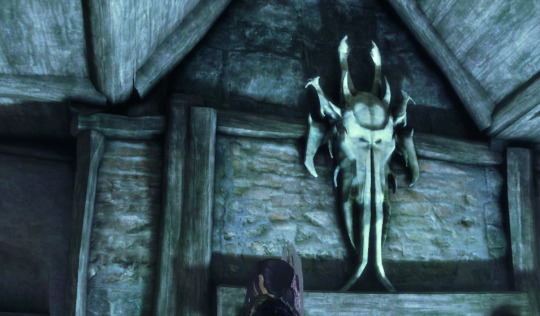
The village and the first floor of the Enchanter’s house don’t have much to offer. We only found the typical dragon-like head symbol, which is a recurrent detail in many Tevinter ruins [Like the Ruins in Brecilian Forest] or in front of the Temple of Andraste. It’s hard to assume with certainty what represents exactly but we can speculate it’s a symbol related to old gods or/and dragons and, ironically, to Andraste sometimes.
The most intriguing part in this house is its cellar, where the child is under the control of a desire demon possessing a cat.
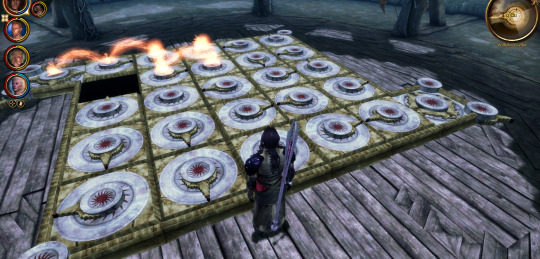
Here, the mage Wilhelm developed a puzzle that, curiously, has the same Chantry-like symbol than the quincunx arrangement found in Brecilian Ruins. We know due to the desire demon trapped in the cat that this is a device to sustain a field that prevents the demon to abandon the place. One may imagine that something of the like was performed in Brecilian Ruins, and went wrong, causing the Veil to thin in that part of Thedas.
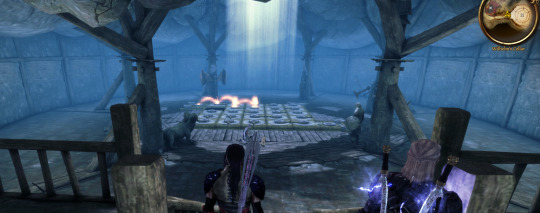
This device has six statues around the puzzle, which make no sense for them to be there.

By the disposition of them, one could assume that these are the entities [the representation of them] that power up the field around this place. But it’s a mere speculation. It feels like they used all what they had to make this DLC without developing anything new, no matter if it made some sense.
Starting from the top left, we have:
The first one is the usual Avvar statue of a man with a shield and a dagger. This statue is used in the Temple of Andraste to represent Maferath. They also appear in The Fade with arms made out of tentacles.
The second one is the same dragon-like Old God statue we found in the Brecilian Ruins during the Dalish Origin, before reaching the Eluvian. It’s the same statue that Tamlen identifies as Falon’Din. This statue is also found in the basement of the Mage Tower of Ferelden [here] where the Circle keeps relics that are mostly from Tevinter.
The third statue is the monstrosity of three heads. It can be found in the basement of the Mage Tower of Ferelden too, and in the Temple of Andraste, as guardians of the entrance towards her ashes. They are exactly in a place where you can find ruined paintings, one of them representing the Old God statue. So far, I could not find any way to link this statue to any lore. It feels like a monster proper of The Horror of Hormak . Or maybe, it’s related to Tevinter, since they have a representation of a three-head serpent statue too. Curiously, you can also find this statue in the residence of the Arl in Denerim [as decoration? lol]
The fourth is a typical statue we find in DAO to represent the Alamarri people. This same statue can be found in the basement of the Mage Tower of Ferelden [here] where it has trapped the soul of Eleni Zinovia who was a former consort and advisor to Archon Valerius, and the mother of Archon Hessarian [the Archon who killed Andraste when she was burning].
The fifth statue must be an Old God, most likely Urthemiel, thanks to the iconography we find in the game files. We saw it in The Fade , and in the basement of the Tower of the Circle of Magi as well. This is the representation of the archdemons that we know were conceived originally according to concept art present in the instruction book of DA:O, but their tentacles made it difficult to animate in the game. In some interviews to Gaider, he explains that this concept was changed into dragons just because animation was easier this way in addition to the requirement that a game called Dragon Age should show more dragons too.
And finally, the sixth statue is a warrior-like holding a sword. I tend to relate this statue as the representation of Tevinter people. In the Temple of Andraste we found this statue related to Archon Hessarian.
It’s hard to understand why such a mess of statues are there, and why they are arranged in a way that may imply they are sustaining the barrier. So far, the purpose of just pointing this out and gathering information related to architecture and statues and symbols we found around has been completed with this post.
My conclusion is that, specially in DLCs, they reuse resources already present in the game and sometimes this works against any intention of reading information in the environment. DAO in particular has always been very weak in this sense, unlike DAI.
[Index page of Dragon Age Lore ]
11 notes
·
View notes
Text
Decline of the Avvar
So just a sad little thing I noticed from the Awakening DLC, is just how far the Avvar of the current Dragon age timeline has fallen back from their heighday when they were just as prominent in the Fertile valley as the chasind and the Alamarri(the people that won the war for the good land east of the Frostbacks, and became the Fereldens).

The Avvar are the Dragon Age's equivelant of the Norse, just like the Fereldens are the equivelant of the Anglo-Saxons and great britains Celts, if they had thriumphed over the invading normans, and reached the high middle ages as Britains dominant culture.
Only where the Fereldens despite their hardships were thriumphant, the Avvar instead is what the Norse would have become if they were defeated, displaced, and pushed further into the wilds by the people who took their lands.

They have become little more than barbarian Goat herders, raiders and hunters, living on what measle food they can produce through animal husbandry, hunting, and raiding. They fight with crude weapons, often stone hammers, or weapons clerly made from crude metal. The only real exception being their exceptional magical weapons of enchanted ice.

Their idea of heavy armor is leather, intervoven with simple metal plates intervowen with leather and furs, to varying degrees of effectiveness.
But it wasn't always this way.

In Awakening, we get a short glimpse of just how advanced the Avvar of that age actually was, and just how far north their traditional people once lived, having been the original masters of the lands around modern Vigil's keep.
They had full plate armor, advanced, enchanted swords, and was skilled enough in stone building that they constucted massive, stone mausoleums.
Either they forged these themselves, or as the designs imply, they traded these armaments from the Dwarves, but regardless, it speaks of a far richer, more advanced, and powerfull society than the current pockets of Avvar civilation left in the modern day.
It also highlights the fact that the "Barbarian Horde" of Holy warriors that Andraste led north to try and snuff out the Tevinter Imperium forever and end slavery, was a far, far cry from the way many people in universe tries to portray them as.
While they might not have been as rich as the Tevinter Imperium at it's height, these were powerful people in their own right, and no wonder is there that they fought the wretched Vints every, single stage of their expansion through Ferelden.
106 notes
·
View notes
Text
Kaddis Masterpost
kaddis is a warpaint with a distinctive smell, so that mabari can tell apart ally from enemy in battle. each kaddis likely has it’s own smell unlike the others.
many seem to be either situational, such as a certain position in battle, or, in the case of the Avvar, religious, to represent a certain god(dess). others seem to be location-based, but it is unclear whether they also fall in either of the two categories above.
red seems to be the most common color overall, in both official art and in the games. other known colors are white, black, yellow, and blue.
kaddis seems commonly restricted to the Avvar, the Ash Warriors, and Fereldens. this is as likely because mabari are both highly valued and rare to be let go or sold outside Ferelden and nearby areas, as it is that because of the association with Ferelden these designs are seen as “barbaric”.
the Chasind very likely have their own kaddis designs, as they do have (unspecified, but likely mabari) dogs, but we’ve no examples of them if so.
there seems to be a lot of symbolism to kaddis designs, though most of the specifics are unknown.
Kaddis of Hakkon Wintersbreath - A traditional Avvar kaddis design meant to invoke the Lord of Winter. (+30% cold resistance)
Kaddis of the Courser - Originating in the Bannorn, this pattern is painted on dogs that must pursue fleeing cavalry. (+2 dexterity)
Kaddis of the King’s Hounds - These designs date back to King Calenhad, and are often used by the royal army. (+30% nature resistance)
Kaddis of the Lady of the Skies - An Avvar pattern sacred to the goddess of death. (+30 physical resistance)
Kaddis of the Mountain-Father - An extremely old design used by Ash Warriors, meant to invoke the Avvar god Korth. (+20% nature resistance, +20% spirit resistance)
Kaddis of the Seige-Breaker - Knights fighting their way in or out of besieged fortifications often use this design. (+30% fire resistance)
Kaddis of the Trickster - This pattern is ancient, said to date back to the days of Dane. (+3 damage) [notes: this is likely a religious kaddis, representing Imhar the Clever, an Avaar (and perhaps Alamarri, once upon a time) God! seeing as the design itself is reminiscent of bones, perhaps Imhar has something to do with death?]
Swiftrunner Warpaint - This dates back to the Black Age, and supposedly brings luck when fighting beasts. (+2 dexterity, +2 damage) [notes: considering the character Swiftrunner also exists, and the reappearance of werewolves in the Black Age, it is possible “Swiftrunner” was the name of either a noteworthy werewolf or more likely a hound who hunted them, and Swiftrunner named himself after them.]
Warpaint of the Tempest - A traditional design used most often in Highever. (+30% electricity resistance)
Warpaint of the Vanguard - This pattern from the arling of Redcliffe is traditional for dogs that fight on the front lines of a battle. (+1/2 stamina regen in battle, based off whether on PC or Console respectively)
Warpaint of the Waking Sea - A pattern traditional to the Waking Sea Bannorn. (+0.25/+0.5 health regeneration in combat, based off whether on PC or Console respectively)
Warpaint of the West Hills - Often used by knights in the lands where Chasind and Avvar attacks are common. (+9 defense)
Warpaint of the Wolfhound - This dates back to the Black Age, and supposedly brings luck when fighting beasts. (+4 damage vs. beasts) [notes: it has the same description as Swiftrunner’s Warpaint and likely was used by werewolf hunters during the Black Age.]
[notes: i am currently missing some photos of unique kaddis from the ostagar battle. however, these are all the equipable kaddis in the game.]
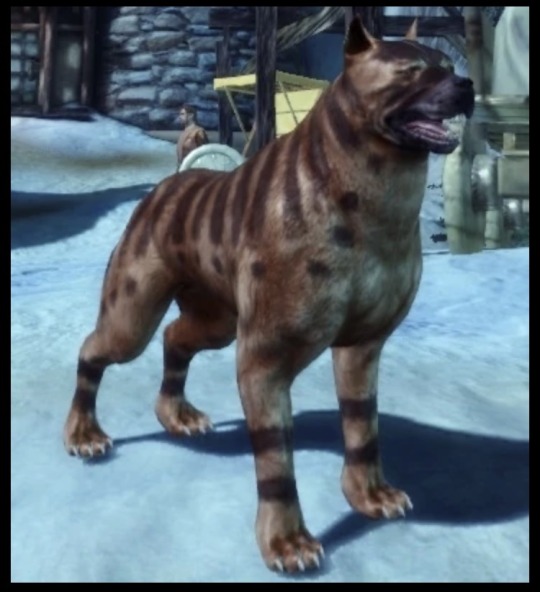
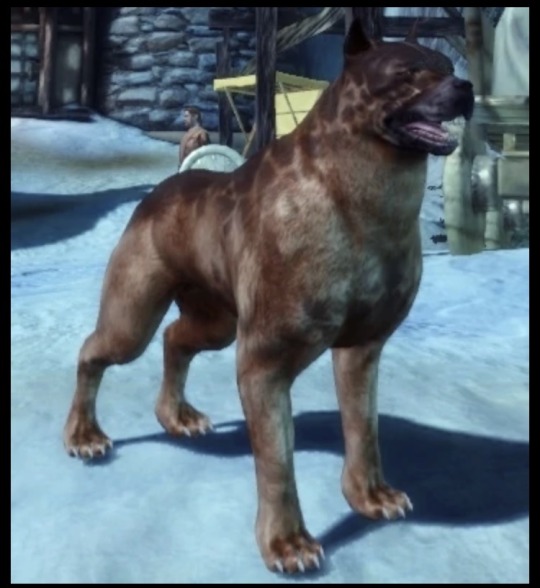
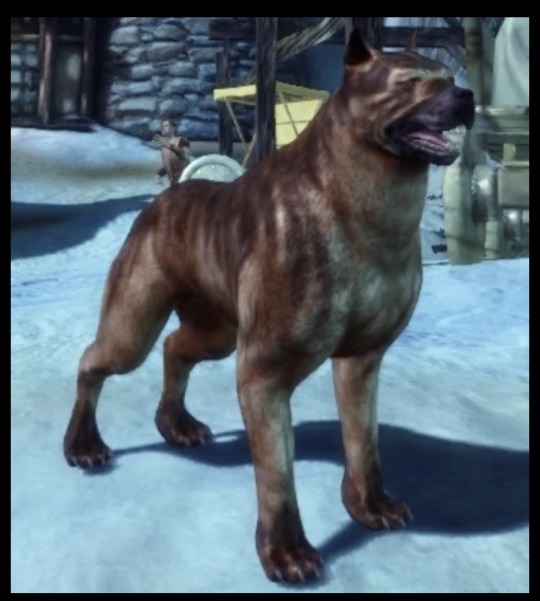
1) a striped and dotted black kaddis with two stripes on the legs. used as warpaint of the wolfhound, swiftrunner warpaint
2) a dotted, almost scale like black kaddis, which covers a large portion of the area around the mabari’s eyes. used as warpaint of the west hills
3) a striped black kaddis pattern faded at the edges, as well as on the paws. used as kaddis of hakkon wintersbreath


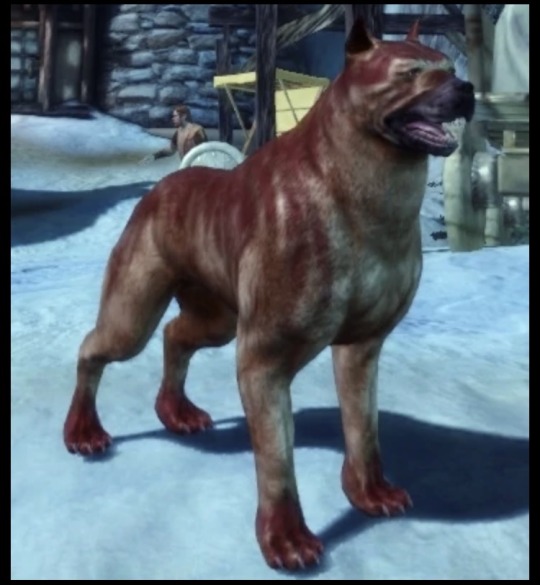
1) a striped and dotted red kaddis with two stripes on the legs. used as kaddis of the courser
2) a dotted, almost scale like red kaddis, which covers a large portion of the area around the mabari’s eyes. used as kaddis of the siege-breaker
3) a striped red kaddis pattern faded at the edges, as well as on the paws. used as warpaint of the tempest
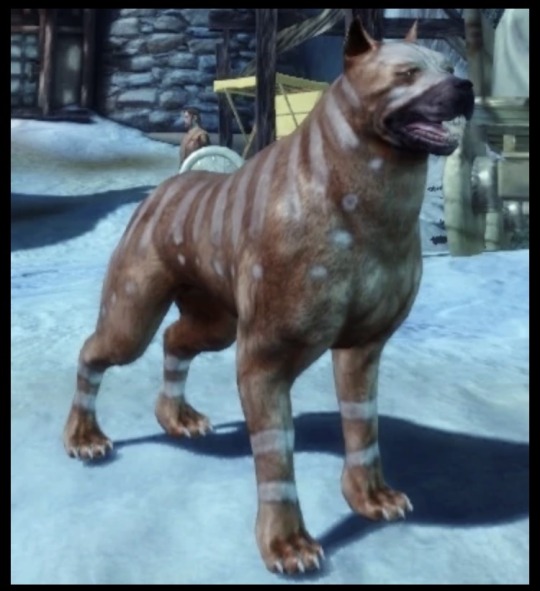
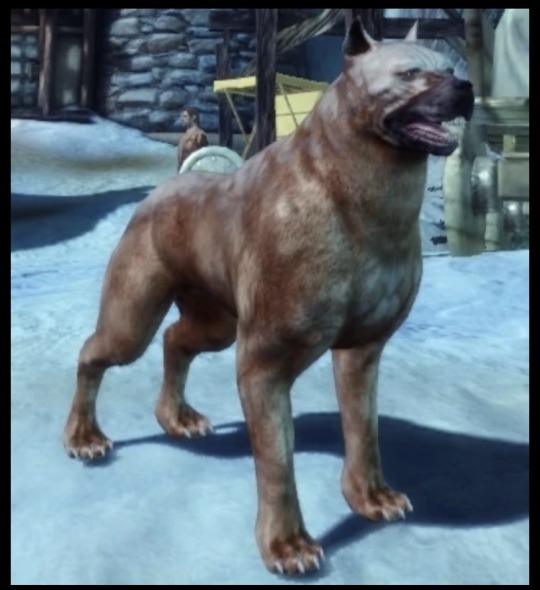

1) a striped and dotted white kaddis with two stripes on the legs. used as warpaint of the vanguard
2) a dotted, almost scale like white kaddis, which covers a large portion of the area around the mabari’s eyes. used as warpaint of the waking sea
3) a striped white kaddis pattern faded at the edges, as well as on the paws. used as kaddis of the lady of the skies
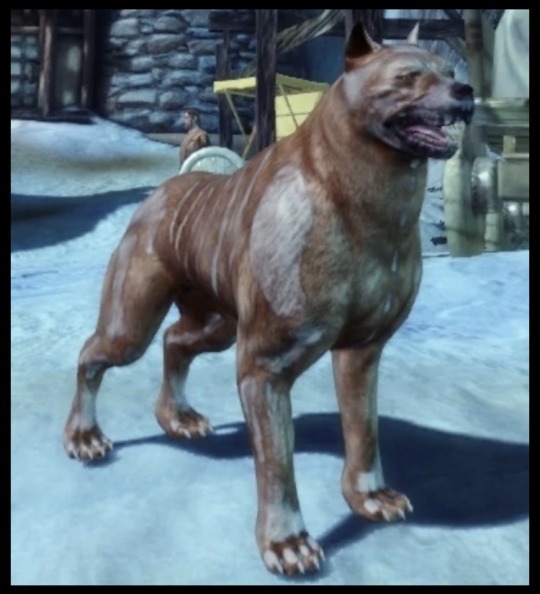
a white skeletal kaddis. used as kaddis of the trickster, kaddis of the mountain-father, kaddis of the king’s hounds
#this post is mostly for me but i posted in case anyone else wants this info in one place 💚#da#bm#rambles#dragon age#da ref#ferelden#chasind#avvar
16 notes
·
View notes
Text
DA:O and DA:2 Loading Screen Texts
“The Andrastian Chantry believes that if the Chant of Light--first written by the prophet Andraste--can be spread to all four corners of the world, the Maker will forgive humankind for their sins.”
“Dwarves have no formal religion, instead venerating the Paragons--those of their ancestors who have contributed in some meaningful way to society.”
“The second elven homeland, the Dales, fell to an Exalted March called on the “heathens” not long after the end of the Second Blight--almost 700 years ago.”
“There have been four Blights in total; the last ended four hundred years ago at the Battle of Ayesleigh. Humanity mistakenly believed the darkspawn were permanently defeated there.”
“The Grey Wardens were once exiled from Ferelden for conspiring to overthrow the king. They were permitted to return twenty years ago by King Maric, Cailan’s father.”
“At the Battle of River Dane, Loghain Mac Tir became known as a hero when he and his men finally drove the forces of the Orlesian Empire out of Ferelden after more than 80 years of occupation.”
“The Grey Wardens were once known for the griffon mounts on which they flew into battle. The griffon numbers waned after the last Blight, finally disappearing completely 200 years ago.”
“Grey Wardens possess the Right of Conscription: they may draft anyone into their ranks without question, from prince to lowly commoner. This is not always done without consequence, however.”
“The dwarven kingdom once encompassed 12 great thaigs spread across Thedas, joined by the underground Deep Roads. Only two remain: Orzammar and Kal Sharok.”
“An elven alienage is a city quarter where elves live, often poor and walled off from the rest, rampant with crime and strife.”
“In their first homeland, Arlathan, elves were immortal and possessed an advanced culture and language. After a millennium of slavery and poverty they lost it all, and even the Dalish have only reclaimed but a little.”
“The Orlesians conquered Ferelden in 8:24 Blessed, beginning a long and brutal rule that ended only 30 years ago. Most Fereldans still remember that time vividly.”
“King Cailan Theirin assumed the throne five years ago upon the death of his father, marrying Lady Anora Mac Tir--daughter of Teyrn Loghain--exactly one month later.”
“The Circle of Magi was formed by the Chantry to keep a watchful eye over the mages. According to the Chant of Light, magic is meant to serve man and never to rule over him.”
“Templars are warriors that exist to monitor mages and hunt down those that go rogue from the Circle of Magi. They have the ability to disrupt magic and drain mana from their adversaries.”
“The Korcari Wilds extends far to the south of Ferelden, stretching into an uncharted frozen wasteland. It is a dangerous place, supposedly filled with witches, barbarians, and monsters.”
“The Circle of Magi's tower, standing off the shore of Lake Calenhad, precedes the mages themselves. It was built by the Avvar a thousand years ago, before being conquered by the Tevinter Imperium.”
“The ancient Tevinter Imperium, ruled by the magisters and powerful blood magic, once spread over all of Thedas. Many of its ruins still remain in Ferelden even today.”
“The Fade is a dream realm where the spirits of all beings but dwarves go when they sleep. Only mages remain conscious once there, but others can “awaken” if they are trapped there unwillingly.”
“The Fade is the realm of hungry demons that constantly seek to pass through the Veil into the land of the living. Those that succeed will try to possess a body, living or dead.”
“Demons are drawn to mages, and should they ever succeed in possessing one they transform them into an abomination--a terrifying and intelligent monster with access to great magical powers.”
“Demons primarily come in five varieties, based on the part of the living psyche that they feed from. From weakest to strongest they are rage, hunger, sloth, desire, and pride.”
“Not all spirits of the Fade are evil things. Some are beings of compassion, fortitude, and justice. They have little interest in crossing the Veil unless summoned, however, and thus are far less known than demons.”
“Ferelden has existed as a nation since the fabled King Calenhad, the Silver Knight, united the warring Alamarri teyrns almost 400 years ago.”
“The Qunari landed on the northern island of Par Vollen three centuries ago, coming from an unknown land far off to the east across the Amaranthine Ocean. They began a war to conquer Thedas almost immediately, one that ended in a truce after more than 150 years of fighting.”
“According to the Chantry calendar, every hundred years is an age--named at the end of the last age according to omens discerned that year. The Dragon Age is the ninth since the ascension of the first Divine of the Chantry.”
“Dragons were once worshipped by the ancient Tevinter Imperium, and existed in number until the Nevarran dragon hunters brought them to the brink of extinction. They only reappeared at the beginning of the Dragon Age, giving the age its namesake.”
“Those that survive the darkspawn taint eventually become “ghouls,” their minds corrupted and twisted to seek out and serve the darkspawn until eventually they die in anguish or disappear underground forever.
“Without an Archdemon to lead them to the surface, the darkspawn remain below in the Deep Roads, battling the dwarves. Few—save for the Grey Wardens—know anything about them.”
“The ancient mining tunnels beneath Hightown and Lowtown now form the city's sewers, as well as the slum known as Darktown. Residents refer to these tunnels collectively as the Undercity.”
“People from the Free Marches are called “Marchers,” but usually only by outsiders. A citizen of Kirkwall thinks of himself as being from the city first and the Free Marches second.”
“The Fifth Blight began in 9:30 Dragon and lasted only a year before the Archdemon was slain. The Hero of Ferelden spared the world from the ravages of another war against the darkspawn.”
“There are fourteen Circles of Magi in Thedas, excluding those in the Tevinter Imperium. The Circle at the Gallows in Kirkwall is one of two in the Free Marches and is the center of templar power in the East.”
“Kirkwall was once part of the Tevinter Imperium and the center of its slave trade. Slaves worked the quarries until they revolted more than 900 years ago.”
“The Qunari live on Par Vollen, an island nation in the tropical northern climes. Some believe they originally came from elsewhere, since they weren't seen in Thedas until 300 years ago.”
“The Qunari invaded mainland Thedas 200 years ago, and were driven back during the New Exalted Marches. The Llomerryn Accord in 7:84 Storm established an armistice between the Qunari and every nation except the Tevinter Imperium.”
“The raiders who plague the waters of the Waking Sea and the Amaranthine Ocean are based out of the chaotic Rivaini city of Llomerryn.”
“Although the slave trade is legal only in the Tevinter Imperium, their slavers are present almost everywhere. They prey on elves and the poor, bringing victims back to the Imperium to sell to magisters and shady foreigners.”
“The largest guild of thieves in Kirkwall calls itself the Coterie. Although the association is very informal, the Coterie is vicious against anyone who looks like competition.”
“The Gallows sits in a harbor that was carved through the cliffs by magic to allow ships to dock in the middle of Lowtown.”
““The Twins” is the local name for the two great Tevinter statues that flank the entrance to Kirkwall’s harbor. They are not merely for show: a massive chain net can be raised between them and the fortified lighthouse.”
“Kirkwall’s Lowtown once held the city's slaves. Individual sections could be closed off in the event of a rebellion, and the winding streets were designed to discourage slaves from attempting to organize.”
“Both the Viscount’s Keep and the chantry were built by the dwarves. They were originally intended to house the city’s magister overlords, back at the height of Imperial rule.”
“The Free Marches is not a single nation, but an alliance of independent city-states. Kirkwall, Starkhaven, and Tantervale are the largest.”
“Kirkwall has been ruled by a viscount since the Orlesian Empire installed one as governor in 7:60 Storm. The city retained the title even after it rebelled against foreign rule.”
“Kirkwall’s less illustrious residents assemble at the Hanged Man. The tavern's feature dish is its stew, made from a different mystery meat each morning.”
“Kirkwall was built almost entirely through slave labor. Part of the city was once a quarry, worked by thousands upon thousands of slaves. Massive quantities of jet stone were carved straight out of the rock face, eventually creating the pit that is now Lowtown, as well as the city’s broad harbor.”
“Kirkwall has had numerous dragon sightings, but they are generally peasant exaggerations. One “imminent high dragon flight” turned out to be an emaciated drake in a pained rage caused by passing a Griffon Helm.”
“Kirkwall declared the common nug a noxious vermin in 5:20 Exalted over fears that the animals carried the Blight. The extermination became known as the Battle of the Squealing Plains. It is not spoken of in polite company.”
“Don't play cards with Qunari--it's impossible to tell when they're bluffing. Don't play against elves, either--they never pay their debts. And never play against dwarves--they'll kill you if they lose.”
191 notes
·
View notes
Text
Lava’s Art Masterpost
Hey, all! Welcome to my art masterpost! I have no idea if this is a thing that is done typically for art, but oh well, I like organizing things, so here we are! What you’ll find here is mostly Dragon Age, with a few non-DA pieces in there, and there’s a range of styles I like to use, depending on my mood. But a lot of what you’ll see will most likely combine lineart with some other form of coloring/shading.
Feel free to browse at your leisure, and I hope anyone who stumbles upon this enjoys what they find! :D And thank you to anyone who sees this and likes, or reblogs, or even just stops by to peruse a bit!
All that said, away we go!
Digital Portraits:
1. Portrait of Nameless Woman, 2020 - This one is just an experiment with a watercolor brush that I did. It’s not anatomically perfect, but I enjoyed playing around with shading.
2. Sketch of Aja Amell, 2020 - This one is basically sketch practice with my Amell~ Not really the most expressive pictures, but it’s a start toward drawing her more expressively. Full disclosure: Aja is one of those OCs of mine that I have had trouble with deciding on a definitive appearance for several pictures, and I really want to work on upping my level of consistency when drawing her.
3. Long-Haired Fenris, 2020 - Exactly what it sounds like; this was for practice drawing Fenris’s features (I love how distinct they are), but with long hair because I am weak for it. This one was a fun piece to shade, and mixing the stylized lineart that I normally use with a greyscale shading spectrum was really enjoyable.
4. Portrait of Ilorin Lavellan, 2016 - This is an oldie. Basically practicing expressions, and it is technically a WIP, but I’m still very happy with how the shading turned out, especially because this is actually (aside from the unfinished hair) one of the more minimal pieces I’ve done in terms of lineart It’s still there, and it still shapes the flow of the picture in some ways, but it also ends up flowing with the shading instead of standing out next to it, which I like. (Both styles are good, though, and I love seeing other artists try both too.)
5. Old Portrait of Aja Amell, 2016 - Much older picture I did of Aja; she... honestly looks very little like the newer one, I think, and that consistency is something I’m still working on, but this one was the first picture of Aja with that particular hairstyle I drew. What I like about this picture is how young she looks; it fits with her image as a fresh and sheltered Circle mage who’s only about 20 years old at the time of DAO.
6. Old Portrait of Trilyn, 2016 - They very first piece of art I posted to tumblr~ It’s not exactly how I envision Trilyn anymore, but it was still very fun to draw, and helped me get a feel for drawing him in the future.
Dynamic Movement Pictures/”Moment’s in Time”:
1. Tabris in Arl’s Estate, 2020 - TW: blood. I am super proud of this one. My ultimate goal is to draw all of my Warden DAO OCs, and I could not believe I’ve never drawn my Tabris, and so here she is. This was, in large part, practicing expressions because I absolutely love art that depicts characters in motion, or capturing some kind of expression.
2. Velyn in the Rain, 2017 - This one was actually based on some art that I saw in a Teen Wolf fic! It was an experiment with a more expressive style (and one of the first pieces I did without lineart left in the finished version) and it was a huge step out of my comfort zone. But overall, I am extremely happy with how it turned out.
3. Jem Nocking an Arrow, 2016 - And here is the lineart version. This was entirely an excuse to draw my DAI baby, Jem, and to do a cool archer pose because archers are my fav, and I love characters in motion.
4. Solas Teaching Trilyn Fade Magic, 2016 - This one was a painterly picture that was also (like the Velyn picture) something which I tried to keep lineart out of. Overall, I am proud of a lot of parts of the pic, but I think I would definitely go back over it and change a few things now if I had the patience.
5. Trilyn Closeup WIP, 2016 - TW: injury, blood, mention of abuse in the author’s note. A lot of early pictures I have are of my OC, Trilyn, and this is one of my absolute favorites. His entire upper body is technically in the picture, but I hadn’t finished rendering it yet, so this was what I posted. And it was an experiment with a cross-hatching style with the pencil tool for some texture, with air brush shading and a blurring tool. It’s a style I had fun playing around with!
6. Trilyn Blood Ritual, 2016 - TW: blood, injury (the slight cut used to supply the ritual with blood). This one was definitely a sort of “captured moment” from a backstory I gave Trilyn, and I think what I was really going for was an atmospheric piece that could fit with any potential fic I wanted to write for Trilyn. And then it ended up being practice for extreme lighting/shading techniques, and drawing the blood and the gross mass of demon ichor (or whatever the heck that is) turned out to be highlights of making the piece for me.
Art + Text:
1. Freedom and Control, 2020 - TW: scars, but very difficult to see. This one was ambitious for me! It started originally just as Solas and my Tal-Vashoth OC, Saara, facing each other, because I love the dynamic I’ve built for them in my head, but then it turned into an attempt at a tarot-esque background, and just sorta grew from there... Overall, I’m happy with how it turned out, especially with how Solas and Saara themselves turned out. The version you can actually see a larger view is here.
2. Marianna and Delia Codex and Art, Pt. 1, 2020 - I love writing my own codex entries, first off, and I love combining art with text to create a (hopefully) seamless work. This work was an attempt to flesh out these OCs of mine with both art (because unique facial structures are hard for me to get down, but so important regardless) and text (because writing~). I think it turned out well overall, but there are elements of the portraits that I might at some point touch up a bit.
3. Marianna and Delia Codex and Art, Pt. 2, 2020 - Part 2, with what I refer to as a “DAI Outfit Change” because I have always loved seeing fans show their own OCs as they look in DAO, DA2, and then finally DAI. So I absolutely wanted to jump on that bandwagon myself. The skin tones are a little off (and I’m sorry about that!) because I was playing with the watercolor brush at that point, and it dilutes the colors I use. Still working to figure that out, but I was very happy with the overall lineart and structures of the faces.
4. Alistair/Aja Amell Picture with a Blurb, 2017 - Ooooold, old, old, old, OLD! I still love the art, and I’m soooo happy with how the interaction between Alistair and Aja turned out (drawing kisses is extremely difficult for me; I always end up creating a distorted weird lip-creature, instead of realistically puckered lips...). I’m not as happy with the blurb that went with it? At that point, I was still very much figuring out my own DAO worldstate, and the characterization for everyone, so, eh. Take it with a grain of salt!
Unfinished Costume Designs:
1. Ancient Elvhen Armor with Dwarven Influence, 2018 - People who do costume design work are amazing and mystical beings, and I wish I could do what they do. This was an attempt at merging the Keeper robes from DAI with a more dwarven armor aesthetic, solely because I created an ancient elvhen character, Ceda, who was taken in by the Cad’halash dwarves mentioned in the Witch Hunt dlc, and I wanted this character to have a mix of the elven style of armor and the dwarven style. I’m overall decently happy with it, but there’s still that persistent level of self-criticism present.
2. Herald of Andraste Outfit WIP, 2016 - This was a very old picture, not one I showed around a lot, but the idea for this was entirely born of my intense interest in how fashion and outfit designs could be used to create a symbolic image for the Herald of Andraste. In general, I love the combination of ceremonial armor with long and flowing cloth, so that was what I went for here. I’m still actually very proud of how this came out, and headcanon something similar for my Herald in my canon DAI worldstate.
Pencil Sketches:
1. Quick Saara Sketch, 2019 - TW: saarebas mouth scars. Exactly what it says; very quick sketch of Saara I did in a small notebook I carry around with me. This was basically a test for myself to see if I could manage to draw Saara with the features and facial structure I envisioned for her without needing to use a lot of references.
2. Mass Effect Character Sketch; Jesse, 2018 - Similar reason for drawing this one as the above Saara sketch! With these characters, I love sometimes the way they can turn out with the specific character creator used for them, and when I draw them, I enjoy trying to create a definitive look for them using what I get from the CC, and my own knowledge of Hooman Faces.
3. Saara Sketch, 2017 - TW: saarebas mouth scars. A more detailed sketch of Saara than the one above, and one I definitely put more time into overall. It’s currently the profile picture I’m using for ao3, and is the definitive go-to reference picture I use whenever imagining Saara in a fic, or for other Saara pics I make. I am extremely proud of this picture, and feel like I should work in graphite more often. It’s such fun, and the texture is so nice to look at.
4. Sketch of Nameless Alamarri Woman, 2017 - This was a sketch I did of what I envisioned some Alamarri tribes to look like; I used artistic depictions of Gaul tribes and hairstyles for inspiration, and have used this as a go-to reference for my version of Alamarri tribes. Nothing super notable about this one, but I really liked the way the shape of her face turned out.
Events and Gifts:
1. Another Scar, 2020 - TW: blood, injuries, gore. The most recent piece of art on the list, and a gift for @cartadwarfwithaheartofgold; featuring sisterly love between Rica and fem!Brosca, which was her requested prompt. This was a tough piece for me because of the difficulty with the lighting I dealt with. For some reason, that one particular element of it gave me so much trouble. Overall, I’m very happy with how it turned out, though, especially the skin tones of the sisters; Brosca I always sort of like as having this greyish, more gaunt look to her, while Rica I like seeing with a darker, richer, and warmer tone to her.
2. A Very Cousland Christmas!, 2019 - This was for a holiday exchange for a server, and I drew a friend’s Cousland (Elissa, the girl on the left) with my Cousland (Gazza, the girl on the right). I love kid-fic, and I love kid-art, and so I decided... baby Cousland art! Drawing kid proportions was the toughest part, I recall, and I thiiiink it turned out well, and I’m still quite proud of it overall. Elissa’s design came entirely from my friend, but I added the holly~
3. Exchange Gift with Dis Brosca and Mabari, 2018 - This was an exchange gift for @fanfoolishness, using her lovely Dis Brosca, and was my first real attempt at backgrounds... I struggled with the coherence of the foreground and background a bit, but I’m still very proud of how it turned out, especially with the colors I had to work with. What I also really enjoyed working with was the lighting and the expression on Dis’s face. Backlit subjects are always fun to play around with!
4. Inktober Picture, “Deep”, 2017 - TW: scars, injury, mentions of abuse in the author’s note/attached dialogue snippets. This was for an Inktober prompt (the only one I’ve ever done, sadly... because I am bad with deadlines...), and again features Trilyn. Trilyn’s backstory has him a former slave in Tevinter, and a lot of the early works I do for him are sort of deep-dives into his life there. It’s all meant to be an exploration of the things he endures, and then those moments when he overcomes it all and takes back his own autonomy and self. This art is definitely provocative, and I can understand if not everyone likes it, but to me, I just wanted to show just what he faces (without glorifying it) before showing the moment of his own triumph.
5. Christmas Holiday Picture with my Brosca and a Friend’s Amell, 2017 - This was a piece of art drawn first by a friend of mine, @nanahuatli~ She drew the Amell, the background, the mistletoe, etc. All I did was add my Brosca to the mix to finish the image. It was a lot of fun to do, 1) because it was fun trying to match her style so that the picture looked cohesive, 2) because I love doing collabs with friends, and 3) because it was just such a fun thing to imagine my surly short Brosca, looking at this weird plant/fungus/thing dangling over some puckering human! It was an absolute joy to do this collab with her!
6. OC Kiss Week Pic of Jem and Saara, 2017 - TW: saarebas mouth scars. A spur-of-the-moment thing meant to demonstrate just what kind of dynamic my OC, Jem, has with my other OC, Saara (both of whom are members of Leliana’s network in DAI). This was a very quick picture (deadlines...) and was mostly just to have fun drawing these two characters interacting, and to see if I could make them look like themselves. I think I did a decent job with it overall, especially with Jem’s kissy-face! (Again... drawing kisses are the bane of my existence, although hands and feet take a close second.)
11 notes
·
View notes
Text
on the topic of tattoos though, I do headcanon that they’re more common in Ferelden, on both city elves and humans, than elsewhere in Thedas.
because Fereldans are descended from Alamarri tribes, and we know at least one (1) of those tribes has tattoos as a cultural thing (the Chasind.) so while tattoos in Andrastian Fereldans may not have the same deeper meanings that they do for the Chasind, the Fereldans are much more chill about it because, hey, they’ve always had tattoos
(I can see this as something the Orlesians tried to stamp out during their occupation of Ferelden, so once the Orlesians are given the boot, tattoos suddenly become a lot more popular in the newly independent kingdom because they can now)
city elves adopt human designs because “we’re Fereldan too!” but they also add their own twists to them, like including city elf motifs (perhaps similar to designs painted on vhendahls)
6 notes
·
View notes
Note
Pppst! Can you talk about your Dragon Age OCs? Who are your faves?
This is a phenomenal Ask!!
My Dragon Age OCs are Azaria Surana, Galen Hawke, Marcel de Serault, and Talyn Adaar.
With the exception of the Marquis de Serault, they are all mages.
[Art of Azaria]
Azaria is a bisexual elf INTJ. She is a mage. As the game establishes, she is both a bright pupil and a powerful one. I figure that Azaria always looked down on the idea of blood magic as a cheap trick to make weak mages stronger until she saw it do just that for Jowan. That was when she began to wonder what it might do for her.
Azaria has a pathological need to be liked. She’s a liar and a manipulator, but most of the people she meets end up finding her likeable and trustworthy. She believes that being a mage makes her better than other people, but didn’t voice her views while studying at Kinloch Hold. The one thing about which she never made any pretense was the chantry, Andraste, and the Maker. The Maker is pretend.
She’s not just a believer in mage rights – she has Magneto-like views of mages. She wants a magocracy because she knows that this is the best way to rule.
As a Grey Warden, Azaria was thrilled with her relative freedom, but aware of the cost. She seduced and deflowered Alistair because literally why wouldn’t you. Eventually, however, it became clear that he was too attached to her. His love for her and desire to remain exclusive, coupled with the knowledge of his heritage, made her gently break up with him. She forced herself to wait a week or two before taking Zevran up on his offer of a “massage.” He was perfect for her. He remains perfect for her.
Morrigan is not only a trusted companion, but her best friend. They share many values. Azaria learned shapeshifting from her, but knows very few forms and does not use this magic in combat.
Azaria named her dog Jowan.
In Redcliffe, she made a deal with a Desire Demon to learn blood magic. She would do anything for an edge against the Blight, and Azaria has no regrets. Her fighting style relies heavily upon fire and blood. She made Alistair and Anora rule together after she convinced him to conduct the Dark Ritual with Morrigan.
Azaria will never succumb to The Calling. In fact, she is determined to prolong her life by any means, and viewed Avernus as a role model in that regard.
Note: when Anders was with the Wardens, she boned him. when Carver was with the Wardens, she boned him. she has great taste. She also did the threesome with Zevran and Isabela.
[I commissioned art of Galen Hawke, but it was lost in the tumblr purge; I still have it of course; Galen’s model is Marlon Teixeira]
Galen is an ENFP and a true Disaster Bi. He’s not as powerful, skilled, or smart as Azaria, but he is outrageously attractive and tends to YOLO his way through life, even – or especally – after facing various family tragedies.
He mostly practices Force Magic in combat, as he trained in that in Lothering to avoid tell-tale signs of an apostate (if people find dead spiders without explanation, that’s one thing. Dead spiders and signs that the entire area was recently encased in ice in the middle of summer? that’s mage work). He grieved his sister Bethany and always wished that Carver were less resentful.
Galen’s mabari is named Hakkon. Galen is not religious, but he grew up with stories of the Alamarri and Avvar.
Galen romanced Isabela and Anders and Merrill and Fenris. I know that polyamory isn’t enabled in the games and I don’t even know if DA2 has a mod to that effect, but that’s my OT5. Galen also hooked up with Jethann and did the threesome with Zevran. Actually, it might be faster to talk about the people in Kirkwall he didn’t bang.
Galen was neutral on blood magic until the murder of his mother, at which point he asked Merrill to teach him. Carver was already a Warden at this point, and Galen wanted to make sure that he’d have every tool at his disposal to protect his family – including his found family. Still, he never really mastered the art or learned to control others – it just gave him an edge in fights and helped him to resist the blood magic of others.
Galen believes in mage rights but doesn’t set out to rule anyone. He might consider himself an activist if he were in our world – though, as a mage, does he have any other choice? He’s not very politically minded. He just wants for him and his friends and everyone they know to be safe and happy, but if he needed to do some magic-murder of some bad people, he doesn’t have a problem with that.
Galen flirted with Tallis. He’s a huge flirt – that’s what he does. Also, he got around when he visited Skyhold.
[I have no art of Marquis Marcel, but he’s a blond fop]
Marquis Marcel just wants to keep his ridiculous, heavily cursed hometown from being overrun by outlaws or intrigue or jungle spirits. He romanced The Wayward Bard, but his thirst for The Silent Hunter is noteworthy. Also, he hooked up with Carver Hawke during the part of The Last Court in which Carver visits.
[Art of Talyn]
Talyn Adaar never expected to become Inquisitor, obviously. She is a distinguished bi and an INTJ. She has a tendency to have somewhat formal speech – a habit she picked up because, too often, humans see their first vashoth and wonder if they can even understand them. She comes across as severe – and she certainly can be severe – but she is a good person who cares about her friends and the fate of the world.
I would say that Talyn is a little more powerful than Galen, but still lower on the magic scale than Azaria. She is a Rift Mage, though in combat she often wields lightning or Force.
Talyn had a casual relationship with Bull early on during her time as Inquisitor. Ultimately, she fell horns-over-heels in love with Sera, who seemed to be her opposite in every way. They married years later, and have matching wedding rings featuring a design with three gold bees.
Talyn’s best friend in the Inquisition is easy to identify – Dorian. Talyn and Cassandra have similar dispositions but different interests. Talyn has a great deal of respect for Vivienne. Talyn was never public with the extent of her dislike for Blackwall, but she regards him with contempt. His lies put her and others in mortal peril. She likes Leliana and respects Morrigan.
She of course secured the best ending for Orlais, with Celene and Briala reunited. Were she to magically read The Masked Empire and have access to all of the information contained therein, she wouldn’t change a thing. She also recruited the mages for obvious reasons.
She was one of those who hooked up with Hawke when he visited Skyhold.
Talyn had never really been religious in any way, shape, or form. She still isn’t, exactly, but after witnessing Hakkon’s spirit leave the physical world in the Frostback Basin, she realized that the Avvar may be theologically correct. Also, she chose to keep the Inquisition to serve Divine Justinia (Leliana).
Anon, thank you so much for asking this!!! (And I’m so sorry that it took so long; I went to bed and then played Anthem with my roommate before he went to work)
PS: the first time, I forgot to answer your question -- Azaria Surana is my favorite. Maybe because she’s my first, or because Origins is my favorite of the games.
#Dragon Age#anon ask#anon#ask#Dragon Age Origins#Dragon Age 2#Dragon Age Inquisition#Hawke#Surana#Adaar
7 notes
·
View notes
Photo
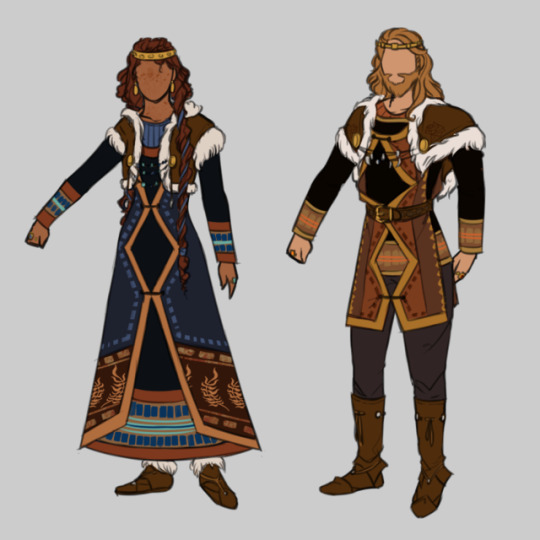
Fashion for Fereldan Nobility (part 1)
This type of dress is worn by Fereldan nobility during the 9:30s. Our fortunate(!) fashion victims are Lorelei Cousland (to the left) and Alistair Theirin (to the right).
This is a continuation of this post. See it as a series. I won’t work in explaining layers again, I’ll just be uploading clothing.
[This type of dress is based on the concept art from tWoT. I hated the puffy sleeves they gave the women though, and I messed around with several designs deemed “Fereldan” before coming to this. Those types of dresses in the concept art are probably based on early and high medieval western forms of fashion, along with medieval norse clothing (think vikings).]
Headcanons:
So this type of dress would be very formal and very old-fashioned. It’s the type of dress you’d pull out for ceremonies. Layers and layers of heavy sturdy cloth, draped with leather and furs, decked out with gold (thread), bone, and gems. The leather allows carvings of your imagery to be placed on there, while the cloth is richly decorated among the seams.
It’s a type of dress centred around history and telling stories of your conquests, home, heritage, etc. Lorelei has her crest’s emblem stitched along, while Alistair has subtle mabari carvings on his leather jacket. The courts of the old Alamarri peoples, conglomerate of the Clayne (Fereldens), Avvar, and Chasind peoples, dressed similar to this. Influences of this dress can be found anywhere in Alamarri conquered territory, from the frostback mountains to the highest point in the Free Marches.
This is part of my Dragon Age meta series (for Ferelden). If you like it, be sure to check out my meta-tag :) Feel free to get inspired, but please don’t re-upload the art anywhere, or use (parts of) it without my permission.
359 notes
·
View notes
Text
vir lath sa’vunin
The end of the Fifth Blight heralds a new dawn for Ferelden and her peoples, but consolidating support for the young new king will not be easy, and rebuilding would be an arduous task even without the threat of residual darkspawn and fresh new horrors lingering in the wake of the Archdemon. Aelinor Surana and Alistair Theirin will need all the strength, savvy, cunning, and knowledge they can muster if they are to heal their country's hurts. With help from friends new and old and their love for each other, they will face down adversity as they always have: together.
Read @ Ao3
Note: "Vir Lath Sa'vunin" is a line from Leliana's Song - the one she sings to the warden after Zathrian and/or the Lady of the Forest die during the Nature of the Beast quest line. It is an old elven song that Keeper Lanaya may share with you in the form of a codex entry. The line means "we love one more day."
Relevant to this chapter: There is an actual in-game conversation you can have with Anora in which she will directly ask you if you and Alistair are together. It really took me off guard because in my playthrough I was careful not to mention anything to Anora about Alistair other than that I think he would make a better king than she thought. But she was too sharp for my love to go unnoticed lol. You can see that conversation here.
Chapter 3: A Fereldan’s Best Friend
Aelinor entered after the announcement of the arls and teyrns in attendance but before the banns. Traditionally, the king’s chamberlain would have been second only to the king, but she had feared seeming too much of an upstart by taking her place at his side, much as he had wished her to dare it. She had become chamberlain during his coronation ceremony and like his kingship it had been openly communicated to the rest of the kingdom, but there had been no separate ceremony conferring the title and responsibilities on her. This would be her first formal appearance as the chamberlain and with so many visiting dignitaries present, she could scarce afford to make mistakes.
She came in through a side door with little fanfare from the major domo as per her request, and bowing to the king, attempted to melt into the crowd and mingle with Leliana’s advice in mind. She could feel many sets of eyes on her, leering, appraising, disdaining. Her heartbeat fluttered in her throat, but she kept her spine straight and her gaze level. There were no mages here, and the only elf besides herself in attendance was Shianni, but there were a few other familiar faces. Her background being what it was and feeling the need to justify it, she inhaled deeply and approached the gaggle of chantry sisters first.
“Sister Justine!” Aelinor inclined her head in the direction of the Denerim Chantry’s curator, who was surrounded by a number of other church officials deep in conversation. “How are your studies progressing?” Sister Justine smiled and motioned her closer. Her dark blond hair was elegantly braided as usual, though there were dark shadows beneath her eyes. Ever since the discovery of the Sacred Ashes’ final resting place she had likely been burning the candle at both ends.
“Lady Surana, come, we were just discussing the latest excavation in the old temple above Haven. The etchings we have made of verses long lost from the Chant are an archivist’s dream–both those you found, and those Brother Genitivi and many others have uncovered since.”
“Long lost? Or stricken?” remarked one of the other sisters with a sour expression. Justine raised an eyebrow at her.
“Wilhelmina, you know very well none of them connect to any of the Dissonant Verses, or perhaps to any verses we know of at all. Taking joy in their recovery is far from controversial.” Wilhelmina sniffed but said no more, narrowing her eyes at Aelinor. Being an elf and a mage and a public official, she was a flagrant offense to the natural order of things most conservative Andrastians adhered to, so it was hardly surprising.
“I can understand Sister Wilhelmina’s caution,” Aelinor said, hoping she would seem reasonable rather than sycophantic, little as she cared to appeal to someone so ready to hate her. “I did find a great deal of these writings in the den of dragon cultists, after all. But so long as we have veteran researchers like Sister Justine and her fellow scholars on hand, I trust they will parse the truth from the apocryphal. In any case, the authenticity of the ashes themselves can hardly be doubted. Without them, all of Denerim may have been corrupted by the Blight now, so I think we can all agree that the Maker had a hand in our deliverance, regardless of what may yet be discovered.” Though Wilhelmina stared her down obstinately, many of the other sisters looked at her thoughtfully or even nodded enthusiastically as Justine did. Leliana’s advice was working like a charm.
Suddenly all the sisters about her were bowing, and Aelinor turned to find that Alistair was standing right behind her, clad in leathers threaded with the strong geometric designs characteristic of the Alamarri. She bowed herself even as she sighed inwardly. He had not held out for very long.
“Your Majesty?”
“My dear sisters of the Chantry, I must allow you to excuse Lady Surana for a moment, as Arl Wulff desires her audience.”
“Yes, of course, King Alistair,” said Sister Justine. “Thank you again to you both for your service to the Chantry. I very much look forward to sharing my findings with you in the weeks and months to come.” Aelinor nodded and moved to Alistair’s side as they walked away. The dining hall was vast and Arl Wulff was located conveniently at its far end.
She noticed Alistair’s arm twitch at his side, no doubt out of force of habit. When they walked alone together, it was rare indeed that he did not take her arm in his own.
“Alistair...”
“Yes, my dear, I know,” he whispered. “I know being within twenty feet of me in the public eye makes you uncomfortable, but people will talk no matter what. We do not need to be miserable, merely professional.” She looked up at his face, but he was staring straight ahead and talking out of the corner of his mouth. So Leliana had managed to get through to him too. She smiled.
“No, you’re right. There have been few female chamberlains in the history of the country in any case, much less mage or elven individuals who have held the position, male or female. They were always going to talk. We can enjoy each other’s company even in public if we are discreet, which you have been. I am grateful for it.” He nodded slightly, and could not suppress a half-smile from quirking the edge of his lips.
“You should be. It’s all I can do not to kiss you right now.” She could feel her flush creeping up the back of her neck again and blessed the high embroidered collar she wore for covering up the worst of it.
“Not to worry, Your Majesty...I’ll be certain to show you how grateful I am once we’re alone.” Alistair said nothing to that and instead cleared his throat a bit too loudly and placed his hand for the briefest of moments at the small of her back, guiding her toward the upper right corner of the room below the dais where the Arl of the West Hills commanded a lively group of nobles. They quieted and bowed at the king’s approach, eying her with curiosity.
“My chamberlain, Lady Aelinor Surana.” She curtsied, and meeting their gazes afterward was not nearly as daunting as she had thought it would be. Of course, it helped to have the king at her side, but this crowd in general seemed to take her presence in better humor than many in attendance.
“How fare the West Hills, Arl Wullf?” she asked. The south had taken the brunt of the horde’s incursion, and would be slow to recover. But she did not want to shy away from the obvious.
“Poorly,” he replied, “but improving with the help of the capital. There is green there still, and the fall will yield a harvest. In the meantime, your efforts with the dwarves to lower the price of provisions for us in the Frostbacks have proven most helpful. And the horde itself is all but vanquished.”
“And yet,” said a new voice in careful, even tones, “is not much of the ‘help of the capital’ owed to Orlais? For it is their Wardens who have bivouacked there with the king’s approval.”
A new face emerged from the crowd, fair-skinned and clear-complexioned. Anora Mac Tir. Aelinor turned and regarded her levelly, but without malice.
“Lady Mac Tir, I need not remind you that while the Wardens have historically overstepped their bounds on certain occasions, their loyalty has always been to themselves and to their mission of protection against the Blight. In the West Hills, the Blight remains and is combated with their help. There is no ambiguity in it in my accounting, but I invite you to find some yourself, should you seek it.”
“If you don’t trust the Wardens’ understanding of it, I wonder what you consider mine, Anora?” Arl Wulff added gruffly. “The self-important prattle of an old man who seeks to solicit favors for his holdings? If you don’t believe me, visit my arling or any portion of the south yourself. The farmers fending off raiding parties and dying of plague will surely lay your suspicions to rest.”
“I did not mean to question the gravity of your situation,” Anora replied coolly. “Merely to point out how easily the enemy might move on us once these Wardens overstay their welcome.”
“Regardless of the loyalty of the Orlesian Wardens, under other circumstances Ferelden would have had its own force,” Alistair cut in, voice hard and sharp with anger. “But fate would have it otherwise, it seems.”
“Indeed,” replied Anora. “Fate would have them on the throne and in the palace chambers.”
Aelinor controlled her sharp intake of breath even as her heart pounded in her ears. Anora had baldly put the question to her prior to the Landsmeet–did she have feelings for Alistair, given the way she spoke of him in such glowing terms? Why did she believe an inexperienced and naive young man like himself could be king? Aelinor had merely replied that she thought Alistair would make a better king than Anora believed and the then-queen had let the matter drop. But of course, she had held onto her read on the situation. It was correct, after all. And Aelinor almost laughed aloud at the pun and how it could be taken as merely a statement of truth or as a double-entendre: a chamberlain in the palace chambers. It was meant to get a rise out of her and Alistair, but she would not let it. Hopefully, Leliana had schooled him well enough that it would not get to him either. She would have put a hand on his shoulder to remind him of the necessity of restraint but of course that would have just put proof to Anora’s thinly veiled accusation.
But before she could so much as speak, there was a commotion in the small crowd as her mabari barreled through the assembled nobles to reach her side, bumping his muzzle against her hand and squeezing in between herself and Alistair.
“What are you doing here, boy?” she said sharply. He wagged his tail and barked with gusto, then looked up at the rest of the crowd with dark, liquid eyes suggesting an innocence Aelinor knew he did not have. “Well, as he seems to have introduced himself without all due courtesy, I shall do my best to atone for him on his behalf. This is my mabari, Shadow. I managed to heal him of the Taint he contracted at Ostagar and he’s followed me ever since.”
Arl Wulff crouched down to get a better look at him and Shadow barked excitedly. “A fine beast. If I am not mistaken, he has recently sired several litters of puppies known for their resilience and ferocity as much as their sweet temper. I gave one such whelp to my daughter.”
Aelinor smiled, grateful for the sudden change in topic. Shadow was a sly creature, indeed. “Yes, he’s been helping to replenish the kennels here in Denerim when he is not at my side. His mate is Bertie, a bitch from the long line of Theirin hounds.” The other nobles gathered around eagerly to ask more questions about his pedigree and the line he was sire to, and Anora’s slight seemed all but forgotten. Aelinor looked for her in the crowd, but she was gone.
“Bertie?” asked Arl Wulff, no doubt amused at so plebian a title for a descendent of the likes of “Sentinel,” and “Duchess.”
Alistair grinned. “Yes, short for Camembertie.” His stomach growled audibly and he leaned over Shadow to speak to Aelinor above the vigorous mabari breeding discussion Shadow’s entrance had set off. “It will be time for dinner soon, thank the Maker. I wasn’t sure how much more of that I could take, but you weathered it well.”
“I’m sure we’ve not seen the last of it,” Aelinor replied, scanning the crowd for Anora and finding her near the group of chantry sisters she’d spoken with earlier. “But I think we managed to make a case for ourselves and maintain our dignity. It wasn’t just my doing, either, Alistair.”
“No, of course not! Shadow takes the lion’s share of the credit.” She rolled her eyes but his slight smile and the gentle tilt of his head in her direction told her that he knew he had done well and that her assurance was enough.
#alistair theirin#female warden#warden surana#alistair x warden#alistair x surana#intrigue! romance! dogs!#what more could you ask for
2 notes
·
View notes
Photo

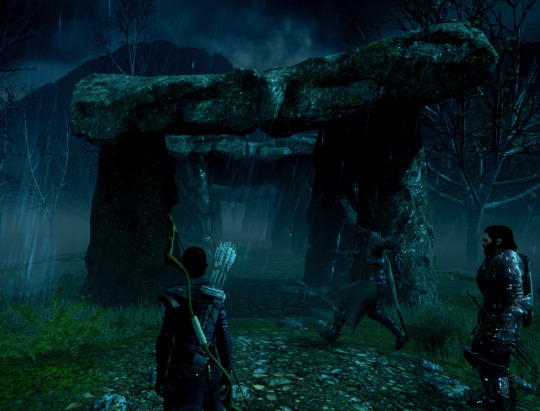
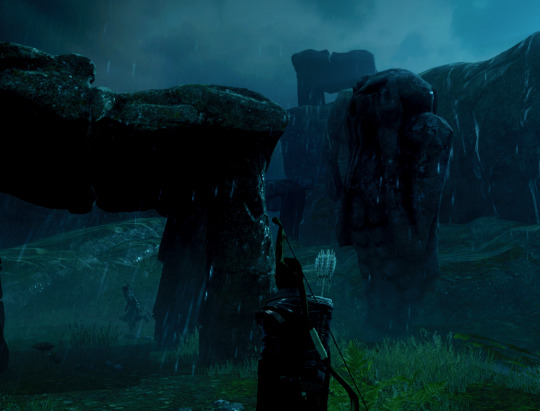
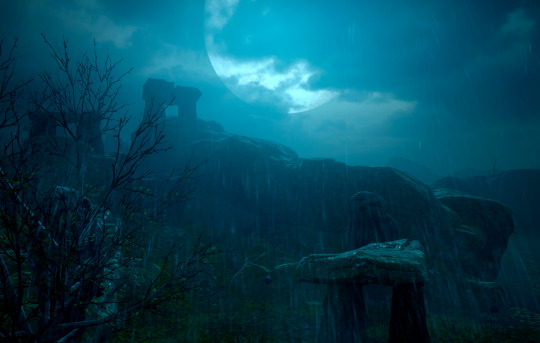
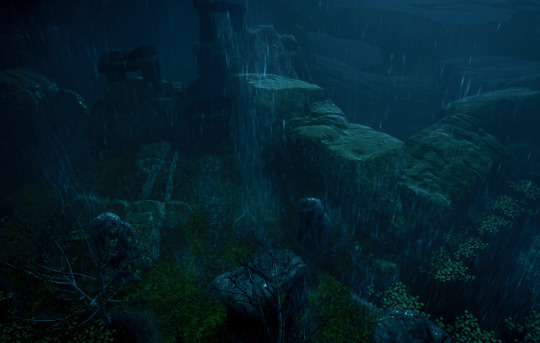

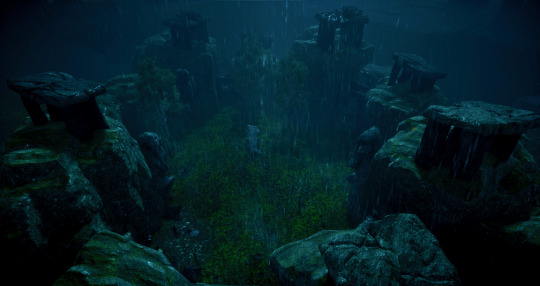


Fallow Mire - Granite Point
Some statues in the Fallow Mire are of Avvar Origin. It amused Bann Hargrave to bring them back from her conquests in the hills and plant them outside her home, the way a gardener might transplant flowers. The Bann entertained visiting nobles by giving tours of the statues, regaling her guests with dark tales of Avvar superstitions, which she mostly made up on the spot.
[Index page of Dragon Age Lore ]
9 notes
·
View notes
Text
Well Shit: The Elvhen Ritual (Part 4 of 4)
We have examined why the Well of Sorrows was so important to the ancient elvhen Sentinels, the origins of the Vir’abelasan, and whether Dirthamen’s Temple once contained a Well as well.
If our theory that the Well of Sorrows is more than a plot device for Inquisition, and that it and many other important story elements for the rest of the Dragon Age series were previewed in earlier games, then it stands to reason there should be something like the Well of Sorrows in Origins or DA2. And it is there.
In fact, most of our Wardens drank from the Well, which could lead to a “Well, shit!” moment for the Warden if they are still alive (and make an [unlikely] appearance) in DA4.
The ruins in the Brecilian Forest are extremely interesting. There are so many important details in them that they could be a series of posts unto themselves. They, and the ruins in the Dalish Origin, point to elves and humans living together side by side after the Veil was created for hundreds of years before Tevinter shows up.
The Wiki says that the Brecilian Forest ruins are probably Tevinter in origin, but honestly that seems highly unlikely given what we find in them and the history we learn from the elf trapped in the spirit crystal. There are signs that indicate these ruins once used eluvians as doors in some places and the presence of what is almost certainly a Well of Sorrows.
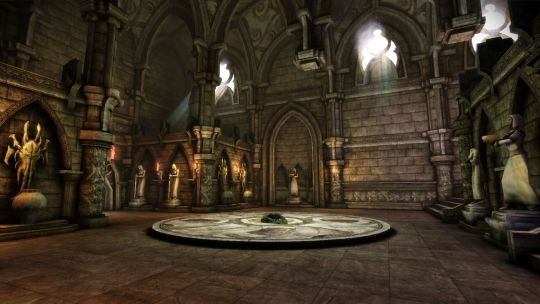
Before we get into the details of who created this well, let's first examine if it is actually a Vir’abelasan. There are many indications that the “fountain” in the depths of the temple was used to prepare the honored elven elders for uthenera, just like the Well of Sorrows. When you pick up the tablet that starts the Elven Ritual quest you get a message that says:
“Most of the carvings are faded. What little you can make out involves a scene where the honored dead is laid to rest inside a grand chamber.
There seems to be some kind of process involving the altar before the body can be laid to rest, but most of those runes are illegible.”
The text could be interpreted as a funerary ceremony, but when you read the codex entry for the tablet, it details a process that seems very similar to the ritual that occurred when servants of Mythal placed their memories and knowledge in the Vir’abelasan before entering uthenera.
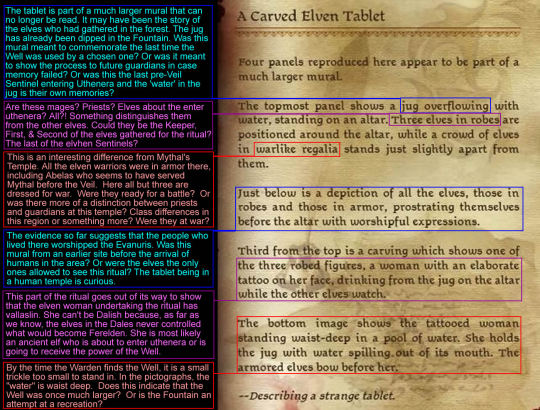
A Warden who didn’t know anything about the Vir’abelasan would, of course, have interpreted these scenes as some sort of cleansing ritual, but post Inquisition the image of an elf with vallaslin standing in a pool pouring something into the ‘water’ while being revered by other elves takes on another meaning.
There are differences, of course. There doesn’t seem to be an altar near the Well in Mythal’s Temple, and the “Well” is very small. The Warden doesn’t seem to gain any great insights or whispers that help them understand the ancient mysteries. Problematic, but not necessarily a sign that it was not a Well. So what else do we have?
There are some other indications that there is a “will” or force influencing the actions of people who come in contact with the Brecilian Well/Fountain. In the text describing the Warden’s thoughts and actions while interacting with the Fountain and altar are very interesting:
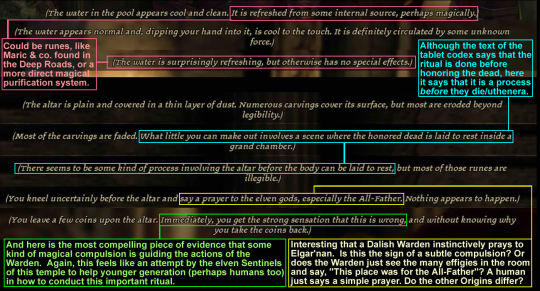
Some force or intelligence subtly prompts the warden away from ‘common’ mistakes, like leaving an offering. It is interesting that small mistakes such as the offering are acceptable, but once the clay jug becomes involved shades punish those who do the ritual wrong. It is interesting that shades attack the warden if they drink all of the water from the jug, leaving nothing to pour back into the fountain. These shades can be defeated with relative ease, but it is a stern reminder to do the ritual correctly.
The warden can still finish the ritual correctly even after the shades attack them, which again suggests that this ritual was supposed to be idiot proof. It was more important to the creators of the ritual that it be finished than it was for it to be done correctly the first time. This suggests that they expected the people performing the ritual to not know the proper forms of the ritual and that they might need a second chance. This is suggestive and we will circle back to this idea in just a moment.
This may not be conclusive proof that this Fountain is a Well of Sorrows, but the totality of the evidence is certainly pointing that way. The images inscribed on the tablet alone make it more than likely that the elves who once lived in the ruins knew about the ritual performed in Mythal’s Temple. Now we have a few other questions to answer: Is this an original Well of Sorrows? A remnant that was revived by later generations of elves? Or was it a recreation of a Well by elves who were not clear about exactly how to do the ritual?
Option 1: The Fountain is an original Well of Sorrows.
Given the number of differences that exist between the ritual we see in Inquisition and the images shown on the tablet it seems unlikely that the Brecilian Forest Well is an original. The elven mage who trapped his own spirit in a crystal just before the temple (and presumably it’s inhabitants) was destroyed, said that the ruins were built by humans, not elves. These two facts together make it very unlikely that the Well is one of the originals dedicated to preserving the Sentinel’s knowledge.
Option 2: The Fountain is a remnant of an earlier Well that was revived by later generations of elves and their human allies.
This is a distinct possibility. All of the history we have of elves and humans in the post-Veil ages suggests that they lived and interacted together in Ferelden. The elf in the spirit stone doesn’t seem to fear or resent humans, but rather describes both races living side by side.
This fits a pattern we see at other important sites across Ferelden. There is evidence at the Temple of Sacred Ashes, the Silverite Mines and Drake’s Fall in Awakening, and Ostagar that humans built important ritual centers and fortresses on the foundations of ruins from Elvhen Empire. (Full disclosure here, the Ostagar evidence is a bit shaky in that the basement area of the Tower is an exact match for the ruins in the Dalish origin. The fact that the designers decided to use that same human/elven motif at Ostagar, however, is suggestive.)
Although Tevinter may have put a decorative spin on these and other locations, there is evidence that these ceremonial centers existed before Tevinter invaded Ferelden.
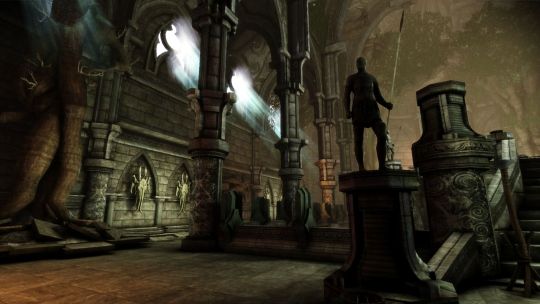
Tevinter had already taken credit (perhaps rightly so, perhaps not) for destroying Arlathan so it is unlikely that any local elven tribes would see them as a potential ally. It is far more likely that the elves found common ground with some of the Alamarri tribes or their descendants, the Avvar, the Clayne, and the Chasind and worked with them to rebuild important ceremonial sites that were laid waste during the wars fought among the elves after the Evanuris were sealed away or that may have been destroyed by the creation of the Veil. This would explain why so many sites have traces of Alamarri influence, but also seem to have possessed eluvians. (I will probably have to write more about this in another post. This one is already creeping up in the word count.)
The fact, however, that the Fountain behaves so differently than the Well of Sorrows, and does not seem to affect the Warden like the Well controls Morrigan or the Inquisitor, points to a third possibility.
Option 3: The elves recreated a Well as best they could, but were not clear about exactly how to make the ritual work as it did in ancient times.
There is also evidence that, while it was based on the Well, the Fountain was actually a not an original item, but an attempt to reclaim some elven glory. Evidence for this possibility can be seen in the text inscribed on the ritual tablet and the “results” of drinking from the Fountain.

The quest text says that the warden uses a series of pictographs, rather than the elven writing, to figure out how to open the uthenera chamber. This suggests the text dates from a later date than Mythal’s temple because the who worshipped there did not need pictographs. They could read elven. How long does it take to forget your own written language?
In the real world, the Maya seem to have lost their ability to read and write in their language in about a century. The combination of the Spanish invasion of their homeland, the wars that followed, along with the diseases brought from Europe were a devastating combination. The Spanish burning Mayan codices and (if I remember correctly) wiping out the Mayan priests along with their religion didn’t help the situation.
This seems roughly analogous with what we see in the elvhen empire. The wars between the elves along with the quickening could have taken a toll on the ancient elves ability to read and write in elven. It probably was a slower loss, but it might explain why the tablet is half in script and half in pictographs.
Of course, the pictographs were for the benefit of the ignorant humans moving into the region, who probably couldn’t read or write elven. There doesn’t seem to be, however, any humans pictured on the tablet so it doesn’t seem likely that they were the primary audience for the tablet.
One final thought on this point: Is the Warden under a compulsion or geas to one of the Evanuris if they drank from the well? And, honestly, there is no way to say yes or no at this point. There is no sign that the Warden is hearing voices like Morrigan or the Inquisitor does, but there does seem to be some mild compulsions associated with the ritual leading up to the Fountain. We don’t know whether the Fountain would have given the warden access to the eluvians that were probably still in that temple when the Fountain last was fully functional. Drinking from the Fountain does give the Warden access to the inner burial chamber, which is reminiscent of Mythal’s Well.
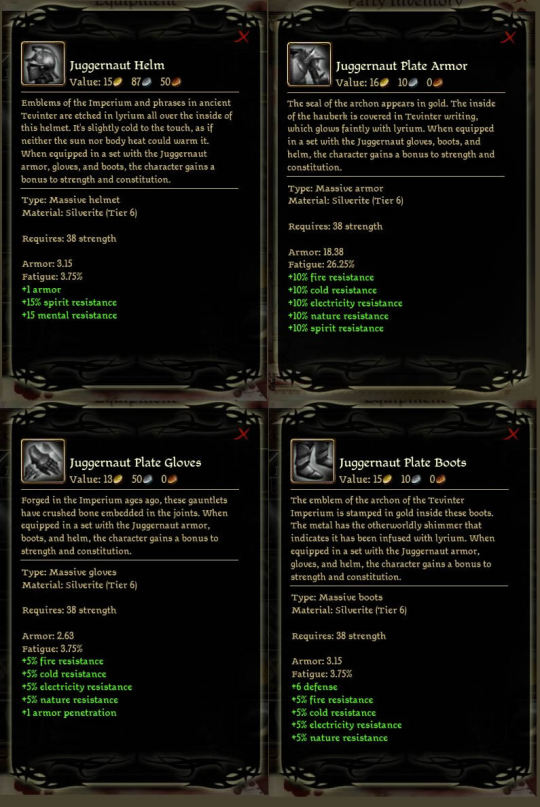
Given the fact that the elves, the Clayne, and Tevinter fought for control of the Brecilian Forest and the last Revenant and piece of the Juggernaut armor associated with the mage’s treasure quest is found in the burial chamber...it is possible the Fountain had already lost its knowledge and there were not enough elves who knew about the ritual to carry on with it after Tevinter was driven from the forest.
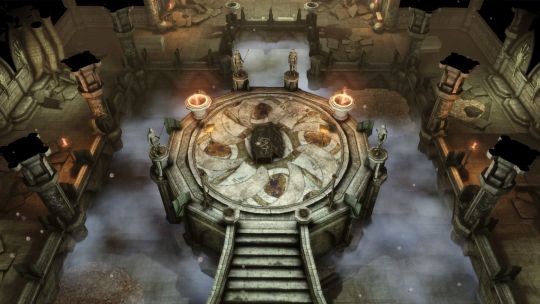
Tevinter had to fight the elves and the Clayne “inch by inch...using terrible magic” to take over the Brecilian Forest. This is reminiscent of the story the elf in the spirit stone tells the Warden, yet we have no proof of whether the temple had already been despoiled in earlier conflicts or if Magister Harach or another Tevinter took the knowledge of the Well.
I also wonder if the Fountain was merely the gateway to the real Well on the inside of the chamber. The tablet said that the elf with vallaslin stood in ‘water’ that was waste deep, and it would be pretty difficult to do that in the little puddle in the outer chamber. Perhaps the real Well was actually the large, misty pool in the inner chamber. All that seems certain is that there was not enough knowledge left in the Fountain to be noticeable to the Warden.
Geas-y Wardens?
So is the Warden under a geas? Even without the knowledge of the Fountain, there may be enough of a compulsion on the Well that the Warden could be in trouble if the Evanuris to whom the Fountain was dedicated is released from the Fade. We have several possibilities as to who that might be. Elgar’nan is all over the room and Andruil along with Sylaise can be seen in the alcoves.
But there is one interesting and almost hidden figure in the room worth mentioning. Look closely at the altar where the water from the Fountain is empowered (or whatever happens to it). There is a symbol for another Evanuris on it.
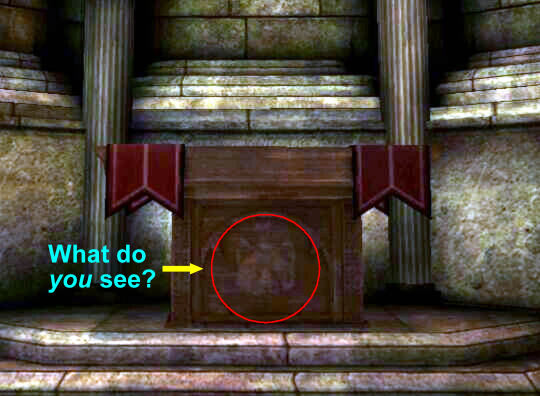
Looks like a bear to me, a symbol for Dirthamen. Could lead to interesting things....
-MM
Think you missed part of the “Well Shit” series? Here are our previous posts:
Part 1: Searching for the Secrets of the Elvhen Gods
Part 2: Origins of the Vir'abelasan
Part 3: Dirth of Knowledge
Part 4: The Elvhen Ritual.
#dragon age#dragon age origins#brecilian forest#Brecilian forest ruins#vir'abelasan#Well of Sorrows#mythal#dirthamen#Elgar'nan#andruil#sylaise#evanuris#elvhenan#dragon age ancient humans#uthenera#dragon age meta#dragon age theories#morta's musings#long post#thanks for reading#life kicked me in the head three weeks ago#took a lot longer than I would have liked to finish this post
129 notes
·
View notes
Text
Okay. So. A thought potentially relevant to the concept of religion in a sitting where perception and belief can be made to literally reshape reality:
The chantry is the majority organized religion for the Andrastrian faith because of a long and bloody history of annihilating other religions, including other, much more peaceful branches of Andrastrianism. As an institution it has more to do with the aims of Kordillus Drakon, founder of the Orlesian Empire and first Emperor of Orlais, than with Andraste.
When Drakon was sixteen he led a military campaign against the largest rival cult of Andrastrianism, the Daughters of Song - thousands of worshippers who refused to take up arms against him. They were either slaughtered or imprisoned, and this set the precedent for Drakon’s rule, and the chantry’s approach to consolidating its power. Drakon wasn’t the only ruler of Orlais to use his religion to galvanize his subjects into condoning atrocities, either, many Divines and Emperors and Empresses of Orlais have upheld this standard, as most notoriously happened during the invasion of the Dales.
The chantry is inherently Orlesian, acting both as a source of military might via standing armies like the Templars, and as a more insidious arm of the empire throughout Thedas. The Free Marches, for example, are supposedly comprised of independent city states, but the chantry has been slowly securing them under the rule of Knight Commanders and Grand Clerics for years - Starkhaven, the largest city state, is ruled by the notoriously ‘devout’ Vael family, and prior to the events of Dragon Age 2, the chantry had essentially seized control of Kirkwall and installed their own puppet viscount, effectively occupying all major seats of power within the city. All cities within the Free Marches host considerable chantry presence, despite their supposed independence, and while Josephine may laud the chantry as a useful diplomatic tool, it can’t be ignored that the institution is Orlesian, and was designed to serve the Orlesian Empire’s expansionist aims. All members of the chantry ultimately answer to the Divine - the post of Divine was first established by Drakon, and is inherently linked to the Orlesian throne.
Drakon’s rule saw the violent end of Old God worship, and the destruction of various Alamarri and Ciriane faiths. The man built chantries over the holy sites of other religions, tearing down their shrines and temples or else repurposing them, building his own massive temple to the Maker out of a Ciriane fortress, and writing his own Canticles and additions to the chant which detailed his visions of conquest and glory. Much of the Chant of Light was penned by Drakon, not Andraste. Drakon was also responsible for founding the Circles, so as to utilize mage labour against the Darkspawn during the Second Blight, and he set a precedent for associating victories against the Darkspawn with the chantry - he used the necessity of fighting back the Blight to invade other nations and establish his armies there. A tactic which Orlais would favour in subsequent Blights, and which would play into Loghain’s fears of an Orlesian invasion in Dragon Age: Origins.
However, all of this information is buried in the lore of the setting, and many characters within it are driven by the presumption that the chantry and Andrastrianism, and indeed faith of any measure, are equivalent, thanks to the chantry’s own propaganda. Criticisms of the chantry as an organization are often refuted with philosophies that apply to religion as a whole, and it is nearly impossible to discuss dismantling the political organization without characters (and many players) presuming that you want to destroy the Andrastrian faith, too. Ultimately, this may in fact lead to the downfall of Andrastrianism within the setting, as the chantry his irrevocably linked several concepts of faith to the bloodstained and self-serving history of the Orlesian Empire. Orlais’ evils, and the chantry’s, are not difficult to prove. Their association with Andraste may ultimately be cause for invalidating much of the major religion of Thedas, which, given implications about the nature of magic and belief in the setting, could prove to be a vital tipping point for the ultimate endgame world state no matter how that all shakes out.
However, it’s also worth considering that if people’s perception has a defining impact on the supernatural powers of the setting, then Drakon and the chantry may have singularly doomed all of Thedas by staining their religion with blood and conquest in the midst of spreading it throughout the continent. Solas speaks of the deterioration of the ancient elves gods, tying them to atrocities of conquest and slavery, which are ultimately comparable to the actions of Orlais, and the chantry, and Tevinter, and also the Qun and even the exploitative caste system of the dwarves.
Which leads me to my new crackpot theory:
The Blight is the result of the corruption of belief, as it expresses itself through the Fade and the various other supernatural powers (i.e. Titans) of the setting. The Darkspawn propagate through murder and destruction, spreading death and inescapable horror, because prevailing belief systems become intertwined with conquest and bloodshed. While those in power can enjoy some removal from consequences of their actions, whole huge populations of people come to associate their systems of faith with blood and death, even as others use them as the focal point for their worship and belief. The reason why creating the Veil sealed off the Blight for a time was because it added an extra layer of separation between people and the manifestation of their will/perception.
That, combined with the banishment of the elven gods, meant that there was a reprieve from associations between religion and conquest. It wasn’t until Tevinter came along and tied its concepts of Old God worship to slavery that this matter began to emerge once again. Breaching the Golden City was a terrible act in part because it weakened the Veil, but it saw the reintroduction of the Blight mostly because it was an act that was achieved through slaughter and horror, and further bolstered by the Imperium’s association of faith and destruction.
The Blight centres on Old Gods because it seeks out focal points of worship to corrupt. The reason why Solas is afraid of the consequences of killing all the archdemons is because once the archdemons are gone, the Blight will not end so much as find another means of manifesting itself - and the current prevailing religion of Thedas focuses its faith on a singular, overwhelmingly powerful deity, who surpasses all others in might.
Meaning, if the Maker is real, he might become the Ultimate Archdemon. And if he isn’t, or if he is actually too powerful to be effected by this kind of thing, then the Blight might still manifest as something comparable to that.
82 notes
·
View notes
Text
Every time I turned around in act 1, I had to hear “The mages went mad with power!”
This is extremely reminiscent of the way mental illness is used to blame individuals for violence, while also turning a blind eye to the violence used to set up and maintain oppressive systems. The same logic is also used to target and abuse anyone who doesn’t conform within those systems.
One person even says that it was “Being locked up in the Circles all those years” that specifically made the mages “mad with power.” I fucking can’t with this shit, Bioware.
And what did the Templars do?
“Stop following orders.”
What this implies to me is that if they had orders, their hunting, torturing, and slaughtering of mages would be completely fucking legit. The Chantry doesn’t see a problem with Templars killing people, they see a problem with Templars killing people without their permission.
And it wouldn’t be that far of a step to get that permission. All one needs to do is twist the facts to make it look like a Circle is harboring abominations or blood mages. Because of the lack of real-time recorded media, telecommunication, and a free (libre) paper press, this is almost too easy. If you know what pieces of evidence you need to destroy or fabricate and who you need to fool, you can create whatever narrative you want. The Chantry does this all the fucking time at its own convenience. The biggest, most glaring piece of evidence for this is the complete absence of Shartan from current canonical texts.
It’s true that this may not always work, and some Chantry authorities are more sympathetic to mages than others. However, the structures of power within the Chantry itself ensure that the best outcomes within it depend almost entirely upon the good will of those who occupy them, from top to bottom. One bad link in the chain of command can fuck things up for a lot of people, as well as make it easier for others like them to gain and abuse power. The near-absolute hegemony the Chantry holds over most of Thedas makes it attractive to anyone who wants a significant degree of power over others. Note that this doesn’t just include people who seek positions within the Chantry - people in positions of secular power have much to gain by appealing to faith. Most noble families have members working within the Chantry on some level, through which they can exercise their own influence. They also have large sums of money and property they can trade for everything from moral endorsement to the elimination of rivals by officially sanctioned means.
To put it briefly, the Chantry is corrupt by design. It wasn’t founded by Andraste, but by Emperor Kordilius Drakon of Orlais. Orlais’ greatest political rival at the time was the Tevinter Imperium, which is, incidentally, ruled by mages. For every other nation at the time, Tevinter was a constant threat, especially with the knowledge that if conquered, they would almost certainly be enslaved, tortured, or killed.
Thus, the narrative of Andraste, a slave of humble Alamarri origins, fighting back and breaking the Imperium’s power would have been a powerful one - which Drakon could easily capitalize on to increase the growth of his own empire. By establishing the Chantry, he could centralize and control the narrative surrounding Andraste and the Maker which had, until then, mostly been Alamarri folk legend.
There were two groups Drakon had to be wary of, if he wanted to stay in power. The first was mages, which he already knew to be a threat due to the power they held in Tevinter. If he wanted to prevent them from taking over from within - perhaps in a fit of desire for power, or revenge on the Imperium’s behalf - he would have to keep magic under tight control.
The other group was the elves. Now free from enslavement and settled in the Dales, they were beginning to establish themselves as an autonomous nation uncomfortably close to the Orlesian Empire. There had undoubtedly also been whisperings of elves wanting to reclaim their ancestral homelands, now in the possession of human nobles.
While humans’ awareness of magic came primarily through the Imperium, elves had no such limitation. Magic and spirits had been a part of their own lore long before humans even set foot among them. Therefore, they may not have been as wary of mages as humans, and would be more likely to protect their own. On top of that, now that they were free to worship their ancestral gods, they wouldn’t be willing to give them up without a fight.
This made them especially dangerous to the Empire. It was Andraste’s words that gave legitimacy to the elves’ land claim, so the first thing Drakon and his successors would have to do is erase those words. Thus, eliminating the Canticle of Shartan and declaring elves as heretics. All this, of course, led to the Second Exalted March.
Through the Chantry’s moral authority, it was possible for the Orlesian Empire to exert control over the hearts and minds of the people, on top of using its monetary and military power to control their land, labor, and material resources. Through the Circle, they can exert control over the only group of people capable of challenging the Empire’s might without needing external power like armies, spies, fortifications and the money to pay for them. Two or three trained combat mages can take out several dozen armed soldiers. You get together a decently sized mage militia with enough experience and you could invade a small country in a month.
But most mages don’t actually want that. They just want to not have Templars watching them pee on top of the constant threat of being imprisoned, tortured, killed or made Tranquil.
Reposting a rant of mine from earlier this month.
0 notes
Text
Speculations about the Vinyl Art

Recently, we had some bits of art that heated up the speculations about the Black City. I write here a detailed set of observations, interpretations and lore speculations.
Most of the images were taken from the source posts of @felassan [here, here, here and here] and andarateia, and I copy-pasted a lot from my draft here. Of course, many of these interpretations are shared with the original authors too since it’s obvious and natural to do these interpretations [specially if one tries to work under the principle of the Occam’s razor]. In others, I may differ, of course.
The vinyls

They are named “Golden City Merge” [blue-teal one] and “Black City Splatter” [Yellowish one].
Golden City Merge
It has a blue-teal colour around a yellow centre that may be golden.
One of these colours coincides with the codex Vir Dirthara: Homecoming, which claims that a “city home” is made of blue glass with spiralling up towers, so only through this detail in colour, and the shape of the city we see in the cover of the vinyl, we can assume that Elvhenan “homes/cities” may have been of this style too. Here, it’s all the lore we can link to these colours.
The only piece of [unreliable] lore we have to blandly link the Golden City with Arlathan is Tyrdda Bright-Axe Path. In it, the man who wanted Trydda’s hand in marriage wanted to lead an army to the North, in order to reach the Golden City. From an Alamarri’s point of view, Arlathan was also in the north, crossing the Boeric Ocean [if we assume, too, that Arlathan was inside the Forest of Arlathan, which is a reasonable speculation given the peculiarities of the place, read The Missing for more details]. This information had been shared to him via dreams by a demon. It is a bland piece of lore because this is a tale that was transmitted through generations, orally, and we know how sensitive to change and modification this process is.
If we keep all these bland speculations, we can play with the idea of assuming that the Golden City may have been Arlathan. If Arlathan was surrounded by Arlathan Forest, the tree theme in the art of the vinyl would add more consistency to this speculation.
Black City Splatter
It has a black splatter over a worn-out, pale yellow colour. It may be considered a “sick” yellow even.
What we speculated from Corypheus’ design is that, due to the way his face was deformed and pieces of metal [or maybe red lyrium] were incrusted in him, it always looked like “something hot exploded” on his left side face [which, coincidental, it was the side which eye was, apparently, blind in his taror card, however, the unmatched eyes is completely inconsistent along art and games]. I talked about this long ago in the end of the post DLC: Legacy and in DA2: Eyes. My point in bringing this desing detail is to say that, when the Magister stepped into the Black City, something “exploded” and melted them, and no matter the Andrastian Myth, we can see it clearly in the design of Corypheus and The Architect. That this vinyl has this colour design and name reinforces the idea that the Magisters unbalanced something when they entered, and it exploded, catching them in the explosion.
The Architect also has a design in his face that tells us that he was melted, and some things were incrusted in his body [I was always curious how a “dragon horn” seems to protrude from his neck]
Although they are focused on the Andrastian Myth, the Tevinter Mosaics seem to reinforce the idea that, when the Magister entered the Black City, they were burnt as well [again, the Myth claims it was the Maker, I suspect the truth is different, but the repetition of melting design in the only two Sidereal Magisters we saw can’t be overlooked].
As a speculation we can assume that the Black City was containing and working properly in the way that Solas had left it when he sealed the Evanuris, until the Sidereal Magisters entered and caused a “burning explosion”. It’s not clear if they caused it with their entering to the City, or touched something that caused it.

the middle of the vinyls show the map of Fade we had in DAO
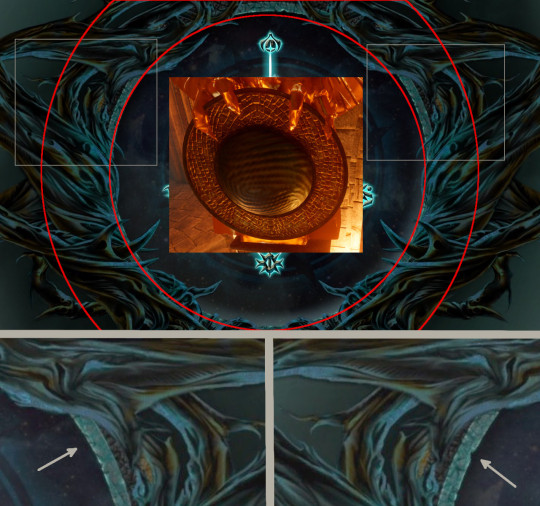
Curious thing, an extraction of this map from the DAO game files, shows that it was surrounded by thorny vines, or something that inspires the idea of thorny vines. And it covers a ring made out of mosaics, very similar to the style of the Golden Ring.

It is also interesting that each of the apexis in the vinyl shows a circle that, according to what my eye can distinguish in that small image, may represent another Golden Ring. These golden rings have been appearing all over the game, specially in DAI.
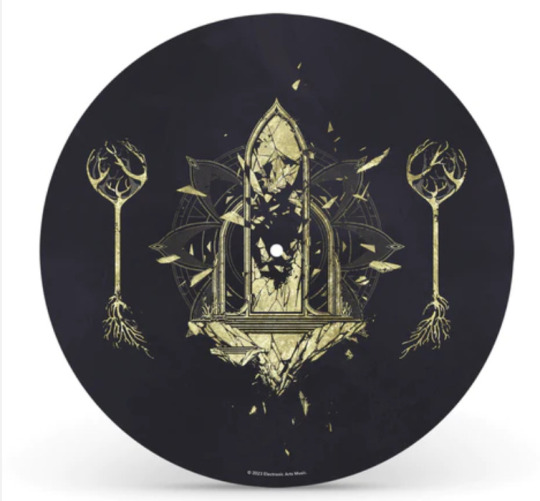
The back of the vinyl shows an eluvian floating on an isle, and two Elven Tree Statue. There is a series of detail we can notice here:
The eluvian is shattered. This gives us the idea that the system protecting the Black City, according to what we have concluded along the posts Murals in DAI: Basics and “The Creation of the Veil”, was broken and whatever kept inside is now free.
Behind it, we see the shape of 6 more eluvians, in a pattern that looks like a flower. The flower may be a mere aesthetic for the vinyl, or could be a representation of the Elvhenan [since the elvhenan banner has a lot of flowers in it, check Elven Ruins to see it], or it may be related to the last bloom of a flower related to the codex “A Flowering Imago” [explanation attempted in the post Ancient Elven codices; Vir Dirthara]
The Chant of Light, if it’s to be trusted with some grains of elvhenan knowledge that was leaked into its text, claims that the Black City has seven gates that, one shattered, will allow the pass of Darkness [Read exaltations in Chant of Light - Part 2]. Darkness has always been associated with the Blight, so I think this piece of info may have been part of elvhenan knowledge that made it into the religious text in ways I explained in “The Chantry and the Mythology of the Chant of Light“. If the Eluvians are gates to the Black City, the seven ones are represented in this vinyl illustration.
The Elven Tree Statues have been seen in many opportunities along the DAI game, and its symbolism is not clear. In the Shattered Library it appears as a source of Fade power, crackling with green energy until the Inquisitor approaches and absorbs it. In the Elven Mountain Ruins, appears as central along the corridor of the Forgotten Sanctuary, and as the main symbol of the Smoking Tower. In Ancient Elven codices; Fen’Harel’s mountain ruins I made a deep analysis of potential relationships of this tree with a source of power to create “in-between” spaces, as well as related to lyrium, the power of the Titans, a Titan’s heart, or Fade itself. It also appears as central in the puzzle of the Dead Hand, where energy is gathered in it, while being surrounded by Golden Rings.

What seems to have in common in all these analysis is that these trees are related to power, and potentially a power to create worlds that may be associated with Titans. Maybe they represent the power that Mythal found when she killed the Titan, according the mural “The Death of a Titan”, and this was the reason why the Evanuris killed her in order to acquire this power. What’s curious is that in this illustration of the vinyl, we see, for the first time, their roots. Which are quite similar to the design of the Mythal’s Vallaslin.
What is this eluvian representing for the Golden/Black City?
The shape of the eluvian is not something to read too much in my opinion. We find these frames in many elvhenan buildings, with other gods too. Even with Andruil in the Shattered Library; Inverted Ward. I think that we have to read it simply as “Elvhenan style for frames” which is deeply related to the shape of door and window frames too, which also carries similar function in the Eluvians: they are “doors” or “windows” to other places in between. I think it’s the typical elvhenan style for frames in general [details in Patterns and Styles: Elvhenan]. There are tons of these tri-style eluvians without flanked beasts spread all over the Elven Ruins. The Crossroads or The Crossroad [Base Game] also show a lot of these eluvians, sometimes flanked by statues, sometimes don’t. A quintuple-style shape is also the shape of the big gates into the Temple of Mythal [check Temple of Mythal, What pride had Wrought: Part 1]. The idea of this shape is that it’s an eluvian with smaller and broader eluvians at the side, overlapped behind, so the final outline looks like it.
The Eluvians are related to the Elvhenan, but also to the Titans in a design point of view: they glow in a similar way as lyrium does or have a similar colour to it. In DAO, we lost Tamlen because an Eluvian was infected by the Blight [and we can justify DAO eluvian as corrupted ones since all of them were non-working or blighted]. So far we know, objects can’t be infected by the Blight, only living things, hence the idea that Eluvian are made of “something alive”. It’s not clear how alive it has to be, since we also know a creepy set of objects that exude “life” in a weird way: The Taken Shape set.
The Eluvians we found in DAO were “Tevinter Eluvians”. It’s not clear if the Tevinter took elvhenan eluvians and modified them to make them work like “communication devices” [as Finn and Dorian explain], or they developed the technology itself. That would also explain why these Eluvians are mostly purple instead of blue [and decorated with human statues that tend to be associated with Tevinter, details in Merril’s Eluvian]. Unaltered elvhenan eluvians have been shown to glow in silvery blue [all of them present in DAI].
Red Lyrium is the product of lyrium being infected with Blight because lyrium is “alive”. So far, this info is what Bianca told us, who at the same time, was told from an unknown source, according to what she speaks about with the Tranquil Researcher in the Emprise du Lion [last part of the post Emprise du Lion: Suledin keep ]. Since we know that Lyrium is Titan’s blood, it makes sense for it to be able to be infected with Blight because Titans are living yet vegetative creatures. On the other hand, there is enough hints to suspect Titans are immune to the Blight, so the lore seems a bit inconsistent on that. More details about this in posts such as Songs and elements that sing and whisper in DA Lore and “The Death of a Titan”.
We also know that the Elvhenan exploited Titan’s bodies in unknown ways, according to all the info we can obtain in the mural from Trespasser: “The Death of a Titan”. Maybe they created Eluvians after they discovered the powers of Titan’s blood. This is a mere speculation about why the eluvian look like made out of lyrium.
Eluvians, then, allowed Elvhenan to do something that, so far, we were told since DAO that magic could not do, according to The Cardinal Rules of Magic: “No one has found any means of travelling—either over great distances or small ones—beyond putting one foot in front of the other.“
There is also a potential interpretation that some Eluvian, somehow, are Gates to the Black City, implied in the mural “The Creation of the Veil”. This information may have survived the ages while being altered into what the Chant of Light claims in Exaltations [Chant of Light - Part 2] as “the Black City has seven Gates”, which is the same amount of “weird bubbles” we see in the mural. It was never clear what’s the reason for having 7 gates to a city you want to seal completely. I have no speculation why Solas could not sealed them completely, and, as it seems, put dragons in them to keep them closed instead.
Eluvians have been used in different ways, as portals to access tombs where elves were slumbering or in Uthenera, but also as “doors to cells”. We have two examples of this: Merril’s eluvian, which, according to Marethari, was a means to keep its Pride demon trapped [details in Merril and the Eluvian ] or as the door to a place inside a pocket dimension called “The ancient Jail” that seems to be a place where slaves or maybe dwarves were taken prisoner by Elvhenan [details in The Crossroads [DLC Trespasser]: Ancient Jail] which entrance has an unmistakable statue of Mythal in Dragon Shape. and inside of it, there are many broken eluvians.

The shattering Eluvian surrounded by two Elven Tree Statue is a similar image to the loadscreen related to Merril that I analysed in the post Merril’s Eluvian, which shows a symbol on the background that I’ve related to Flemeth/Mythal and potentially to Andraste too. Since Merril’s eluvian is related to a prison, maybe in the vinyls we are talking about the same: The Golden/Black city had become a prison for the Evanuris. We know this because Solas himself told us in Elven Ruins that he had banished them.
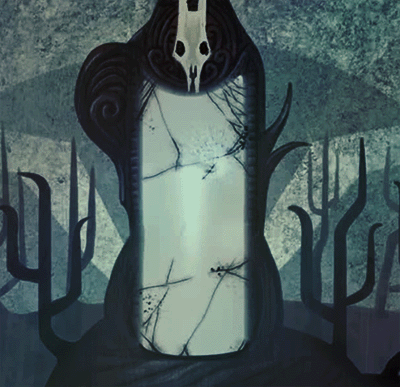
Therefore, a shattered eluvian seems to represent the destruction of a prison, in the same fashion it represented the escape of the Pride Demon in Merril’s quest [see that in the loadscreen gif above]
What the vinyl is telling me with the Shattered Eluvian and seven of them forming a flower, is that we are going to see the release of the Evanuris from their magical prison.
What have to do those trees in the illustration? It could represent the forest of Arlathan where Solas sealed the Evanuris in the city deep inside it. Another option is, that somehow, this prison is sustained/supported by Mythal, or was motivated by Mythal [probably with her death], since these trees seem to represent power, Titans, and Mythal at the same time. Trees are also related to the vhenadahl, which seem to hide a darker meaning that has nothing to do with what the Dalish or city elves believe about [more details in the section vhenadahl in the post “Red Lyrium Idol”].
Mythal as a motivator: If we take Solas’ words in the Elven Ruins, he sealed the Evanuris because they killed Mythal, but we also know in the Dev’s note from the mural “The Death of a Titan” that he really wanted to hide everything they were doing to no tempt anyone else to use this power.
Mythal as the last Guardian: We also know, according to Flemeth’s words in DA2, that Myhtal can exists in different places, as long as there is a “small piece” of her somewhere.
Flemeth in DA2 says:
“I’m a fly in the ointment. I am a whisper in the shadows. I am also and old, old woman. More than that you need not know”
“Must I be in only one place? Bodies are such limiting things. I am but a fragment cast adrift from the whole. A bit of flotsam to cling to in the storm”.
In DAI she says
“Once I was but a woman, crying out in the lonely darkness for justice. And she came to me, a wisp of an ancient being, and she granted me all I wanted and more. I have carried Mythal throuh the ages ever since, seeking the justice denied to her. [...] But what was Mythal? A legend given name and called a god, or something more? Truth is not the end, but a beginning.”
“I nudge history, when it’s requiered. Other times, a shove is needed.” [chuckles]
[Mythal came to me] “for a reckoning that will shake the very heavens.”
Morrigan: And you follow her whims? Do you even know what she truly is?
Flemeth: You seek to preserve the powers that were, but to what end? It is because I taught you, girl, because things happened that were never meant to happen. She was betrayed as I was betrayed - as the world was betrayed! Mythal clawed and crawled her way through the ages to me, and I will see her avenged! Alas, so long as the music plays, we dance.
When elven inquisitor asks her
Inquisitor: Why haven’t you [Mythal] helped us? We’ve called to you, prayed to you.
Flemeth: What was could not be changed.
Inquisitor: What about now? You know so much....
Flemeth: You know not what you ask, child.
Flemeth, about Kieran:
“He carried a piece of what once was, snatched from the jaws of darkness.”
So I think this also may show that Mythal’s retribution is coming. Flemeth has been doing a lot of mastermind work along the ages to give Mythal her deserving revenge associated with the destruction of the Evanuris that, it seems, Solas will perform [since he absorbed Mythal’s powers]. These words were always present in any path you pick, so they are key. Flemeth says that she will stay in this path as long as the “music plays”. This seems to refer to the music of the Darkspwan and the Archdemons that, thanks to Avernus, we know it’s linked, at the end, to something calling from the Black City too [read Songs and elements that sing and whisper in DA Lore and the last part of DLC: Soldier’s Peak]. What I understand is that Flemeth will not be in peace until the Evanuris are destroyed completelly. Which seems to have been Solas’ goal since forever, but lacked power to do it in that moment and he only managed to seal them and borrow some time [and power, since the orb was gathering Fade energy for a millenia]. This plan, of course, was ruined by Corypheus.
In short, considering Flemeth’s words about how shape is limiting, I wonder if there is a chance for Mythal to be in some shape or form, linked to the Golden City, in her Dragon Form, sealing the Evanuris. This hypothesis seems unlikely because Solas told us that Mythal died in some way. You can’t die and be a guardian at the same time.
However, here comes the last hypothesis I can muster: Mythal as the thing that was sealed in the Golden City, fused with the Evanuris. I think there is little to mistrust about the fact that the Evanuris indeed are trapped in the Black City, however, this illustration may imply that Mythal, in her dragon shape, is sealed there too. Considering Flemeth’s words, that sugest she is just a small fragment from the whole, cast adrift, and that can exist in different places at the same time, I wonder if Mythal, in a corrupted, draconic shape, belongs to the creatures that were sealed in the Black City. Maybe she is the ultimate danger, fused with the other evanuris, corrupted and mad by the Blight that “killed” her [when the Evanuris are hard to kill, according to Solas’ words in Somewhere[DLC Trespasser]: Elven Ruins]. This is a bit weird concept, to be fair, but I think that it tastes to “Bioware plot twist”.
The cover and the back
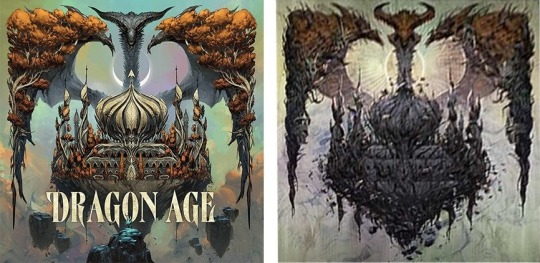
Let’s analyse the illustrations while constrasting these three hypothesis. They show two different versions of the same illustration, a non-corrupted and a corrupted one.
The front cover [details can be seen in this webpage ]: We see, in general, the Golden City with a Dragon behind, extending its wings onto the city, as if they were protecting it. I will call this image the “non-corrupted” version. Now, let’s go to the details.

Facts that can be seen in a better quality image:
The dragon is black or dark coloured with a blue accent. It has slightly curved horns and red glowing eyes [image 1]. From their wings, a dense golden-like canopy raises. In some parts of the drawing it looks like a golden vine spread all over the dragon’s wings [image 2]. Despite being in front of the source of light, the dragon does not cast shadows onto the city. The illustration seems to inspire the idea of “guardian” or “protection”.
The lower parts of the Dragon’s wings show branches that have no leaves, but look like single insect wings pending from branches [image 2, arrows]. Could this be related to the codex “Flowering Imago” from Ancient Elven codices; Vir Dirthara? I don’t know.
The area of the wings without branches shows a texture of red veins which can be perceived as veins of an animal as well as veins of a leaf [image 5].
Behind the dragon there is an Eclipse almost happening.
The cupule of the building shows small typical details of Elvhenan design that I talked and pointed out in the post Patterns and Styles: Elvhenan. The windows look the same design that the elvhenan ones [image 3].
The four spires that can be seen in the city are repeated upside-down, in shadows, implying this place may be similar to the Inverted Ward [image 4, arrows].
The gates of the building resemble strongly the gate of the Temple of Mythal, displaying a draconic image, similar to the statue of the dragon shape of Mythal [image 7].
The trees that rise and entangle with the building seem to be one with the structure, giving it more stability. This gives me the idea that the Dragon, related to these trees through its wings, keeps giving protection and stability to the city.
The whole city lays on a small floating isle.
In front of the isle, there is a tiny humanoid figure with a staff that displays the shape of one of the symbols of the Archdemons [image 6]. I talked a lot about this symbol in the post “The Destruction of the Veil“, linking it to Darkspawn and The Architect.
Around this figure, several birds or winged insects fly around [image 6, arrow].
The space around the city is bright and colourful, reinforcing the idea of a vivid city.
The back cover [details can be seen in this bigger image]. We see, in general, the Black City with a Dragon behind, extending their wings onto the corrupted city, as several faces with symbolic helms are fused in its wings. I’ll call this version the “corrupted” one.


Facts that can be seen:
The dragon is black or dark coloured with red accents. It has curved horns, and a second pair of horns protrudes from its jaw. It’s not clear for me if it has yellow glowing eyes or red ones [image 8]. These horns seem to have a resemblance with the Dragon version of Flemeth in DA2, but not in DAO [ but we know DAO engine was always poor for environmental telling and design details]. Flemeth’s hairstyle doesn’t resemble to any of these horns [image 8]. However, the strange tiara that Flemeth wears seems to coincide a lot with the horn structure of her Dragon shape in DA2 [the tiara has some curves on her temple that resembles the smaller horns in her dragon shape - blue and orange arrow-]. There is, of course, the meaningful yet mysterious central spike too. This spike, which relates Mythal with Andraste and other figures in DA lore, is not present in the corrupted dragon’s head. Considering how important this main spike is for lore, I believe that thinking in this dragon as Mythal may be a mistake [but then again, this is a corrupted dragon that may have suffered a transformation due to the Blight].
From its wings, a dense withered-like canopy dies. The corruption is deeper and more blackened the closer to the extreme of its wings. This corruption looks like black vines, but lacks of thorns. We know that thorny vines are related to the Blight since DAO games. We spoke about this in posts such as Murals in DAI: Basics.
Fused with the corruption of its wings, we see six heads, many of them with clear elven ears. All of them are wearing a helm with the symbols that we identified with the Old Gods / Archdemons in the post of the mural of “Red Lyrium Idol” and “The Creation of the Veil” [image 9].
The area of the wings without branches shows a texture of white veins, and in some parts of this darkened area, bits of orange that seem to imply something is burning inside this corrupted body. Looks like small peeks of Red Lyrium [image 11] or lava.
Behind the dragon there is an Eclipse happening, so the shadows projected by the dragon fall all onto the city. The Design of this Eclipse looks the same like the design of the (alternative) logo of Bioware for Dragon Age Dreadwolf [image 10].
The building is completely overtaken by these black vines, which destroy the infrastructure. It even destroys part of the isle where the city was built upon. We can see that these vines spread deep into it. The corrupted trees are not sustaining and reinforcing the structure of the building but attacking it. The Dragon “lost” its protective nature.
All these black vines remind me a lot of the strange Tentacles we find in the Fade of DAO [image 12]. They protrude from structures or the ground, and some of them even from statues. Maybe it was a concept related to the Old Gods when their design was more related to a Cthulhu creature with tentacles for feet. Check DAO screenshots in the posts The Fade - DAO and The Fade: The Undying Blackmarsh – DA Awakening
There is no tiny humanoid figure in front of the city anymore. However, the symbol that this figure had in their staff is the symbol we don’t see among the faces fused in the dragon’s wings [Image “?”]. This would mean that one of these creatures “escaped” this fate.
The colour of the space around the city is darkened, desaturated, and with “smoke” vein in the air, reinforcing the idea that this space has been corrupted deeply.
Speculations
The Dragon
The dragon and the dense vine rising along its wings, making it look like trees in the non-corrupted version suggests several potential representations:
1) This strong presence of the Forest theme in the dragon may relate this city to Arlathan, which was located in a deep, dense Forest entangled with the Fade, according to the comic The Missing. This would help us link Arlathan and the Golden City as the same place, since it has been very obscure in DA lore the whereabouts of the city of Arlathan. The only hints we have are the Tyrdda Bright-Axe Path, in which the man who wants to force Trydda in a marriage with him claims that whispers told him to conquer the Golden City at the North of their lands, which is a location where the Forest of Arlathan, and potentially the gone city, fit. The unreliable Dalish tales also claim that Alathan was sunk into the underground by Tevinter [details in Arlathan codices from Ancient Elven codices; Din'an Hanin– Elgar’nan Bastion]. There is no more pieces of lore or hints that explain the whereabouts of Arlathan.
2) The dragon seems to be a symbol that may represent Mythal. Another speculation is that this Dragon was Mythal, and the Golden City [maybe Arlathan], may have been her city or the city where her fate was sealed.
According to the unreliable codex [The Temple of Mythal], it seems to be an archeological fact that the Elvhenan used to have a main Temple surrounded by a city developed around it. We know the Temple of Mythal lays in the Arbor Wilds, and we can see some ruins that may fit the idea of a “city/town” before reaching the central part of it [see Temple of Myhtal - Part 1], so the hypothesis that the Golden City was Mythal’s main city seems discarded. However, we also know that Mythal may have had many cities and the biggest ones among the Evanuris thanks to the codex "Song to Sylaise” from Ancient Elven codices, Temple of Mythal.This city can be one of the many that belonged to Myhtal as well as the place where her fate was sealed.
3) This dragon may represent one of the ancient gods that the Elvhenan worshipped before becoming gods themselves. This city also may have been the temple of an ancient dragon that the Evanuris worshipped in the begining [according my interpretation of the Elvhenan lore, explained here], but it is hard to speculate further. There is no much lore but some visual hints on this matter.
4) If it is the city where Mythal’s fate was sealed, we can imagine that the Evanuris, desiring Mythal’s natural Dragon shape, may have invited her here and may have made experiments with her [as we know some Ghilan’nair’s experiments were performed in Tevinter Nights: The Horror of Hormak, that may include some fusion of animals in order to modify their shape]. Let’s remember that the Evanuris were related to winged shapes, “a shape reserved for the Divine and their Chosen” [from the codex Ancient Elven Writing]. If this is the case, the corrupted version of this dragon may represent Mythal, corrupted, and also, displaying her recknoning upon the city, where the other Evanuris were sealed by Solas. She and the others are fused in the corruption itself released by this hypothetical experiment.
There is also a chance that Mythal, in her dragon shape, is still protecting the city, trying to contain the spread of the Blight thanks to the natural Blight-resistance that Dragons have. This concept is only inspired by Flemeth’s words about hinting the fact that she can be in many places at the same time, and bodies are limiting things [there is also a strange hint in the old quest of the Blackmarsh, where a demon in human shape could be in the Fade while a dragon-like shape related to it could be in the Waking World, details in The Blackmarsh and the High Dragon]. Maybe some pieces of Mythal were spread in the world to preserve a bit of her, while her [corrupted] Dragon form remained sealed with the evanuris or maybe she is a guardian of the corupted city. Flemeth also claims to an elven inquisitor that Mythal “changed”, and according to the corruption version of this illustation, Mythal may have changed, and acquired a more menacing looking, as her horns changed too and lost her central spike, such an iconic element in her design.
The inner side of its wings are consumed by the Blight, but the top external side is still resisting. So, the dragon resists the Blight, protecting or isolating the city even though the dragon’s horns changed, and it is “a different/corrupted” dragon. To me this double image represents what the mural “The Creation of the Veil” implies: the Black city, for an unknown reason, has 7 gates that could not be closed and were protected by creatures that could resist this corruption as long as possible: 7 dragons. This idea is a bit supported by the fact that Flemeth always tried to protect Urthemiel’s soul by teaching to Morrigan to protect “what was once” and telling her to have the baby. Urthemiel cannot be an Evanuris that killed Mythal [remember that Mythal wants revenge for that betrayal]. And Urthemiel is a dragon, as we saw him in his Archdemon form, and Mythal/Flemeth is also a dragon, so maybe she is part of the group of these dragons that were powerful “ancient gods”, potentially worshipped by the Elvhenan in the beginning until they got their own divinity. From that moment on, these dragons became the Forgotten Ones, chased by Andruil to the Abyss, and later, worshipped by the Tevinter as “Old Gods” that reside underground. I explained a bit this idea in the post Attempt to rebuild Ancient Elvhenan History.
5) This dragon maybe is not Mythal, but another archdemon, or maybe the mysterious 8th Old God. I never know what to do with that bit of information: the codices of the astrarium imply the presence of an 8th old god dragon that makes no sense to introduce in the lore so late [Constellation: Draconis]. Is this dragon related to this illustration? I don’t know.
As a detail, the wing veins in the non-corrupted version are red, and I am not sure we should understand them as veins of red lyrium. Because, first, it makes no sense to have red lyrium inside a dragon's body in a version which is not the corrupted one, and second, if it were the case, it would imply that Dragons, [these ancient dragons] used to have lyrium instead of blood, which would relate dragons to Titans as the same creatures. And despite the fact that the lore seems to show some similarities between these creatures when it comes to their powers of manipulating Reality or being underground, sleeping, it seems extremely odd. It’s too big of a concept inside the lore of Dragon Age to take it lightly, because it would imply that dwarves are “dragon children”, and things will get more confused when thinking in the “crafted race” of the Qunari.
The two versions of the dragon indeed look like different ones. I’ve been speculating long ago that, so far we can gather from comics and codices, the Elvhenan, in particular the Evanuris, were looking for means to obtain Divinity. The Dragons seem to be extremely old, and ruled the skies when “everything sang the same song” [Yavana’s words]. We can also suspect that the Great Dragons had somniari powers, meaning that they could change reality through the alteration of the Fade [The Silent Grove, Those Who Speak, Until We Sleep] and mortals could attain some degree of this power via their blood. On the other hand, we find in the last comic [The Missing] a mural of potential Evanuris wearing dragon-like outfits. This fits with the old codices of the Elvhenan we found in game, where “divinity was related to the shape of something with wings” that we can assume it’s a dragon. We have several hints pointing to us that maybe, the Evanuris, when they were generals and mages, worshipped “ancient gods” that were Great Dragons, until they found a way to manipulate their own shape to become dragons themselves. Maybe here the Titans appeared as the means for this transformation [in The Horror of Hormak we see that this process of fusing shapes include crystals that seems to be made out of lyrium, maybe these are the Titan’s heart?]
We know that Evanuris did something terrible with Titan’s power that forced Solas to hide all that monstrosity, collapsing the Deep Roads in order to avoid anyone attempting to reach that power again. The codex associated with this event may transpire hints that can be related to a terrible thing being unleashed that may have killed Mythal [or maybe corrupted her? Details in “The Death of a Titan”]. That could be the Blight, or the red lyrium, or something worse that originated these two diseases.
We also suspect that the Forgotten Ones and the Evanuris had been at war for a long time before the Titan War, so how did the Forgotten Ones fit in the reconstruction of this past? It’s hard to say with precision, but some bland and weak hints may imply that the Dragons that have been leading Blights are, in fact, the Forgotten Ones [the only weak proof we have about this connection is through Hakkon/Geldauran in Elvhen Tomb]. This means that the Forgotten Ones may have been dragons [or more likely Great Dragons] and not elvhenan, and, when the Evanuris released the evilness that they created [probably The Blight], it was the Forgotten Ones [naturally resistant to the Blight, read Josephine’s result in Learn More about Dragons] who became the protectors and the means to isolate that disease from the rest of the world until finding a solution.
The Eclipse
Eclipses are associated with Fen’Harel and the events to come, according the codex The Emergent Compendium: an ancient magical tome that produces images and text on its own [DA2]. One of the pictures it manifested was described as "Two shadowed spheres among stars", and it was accompanied by a subtitle that could be deciphered into the phrase "An eclipse as Fen'Harel stirred." [I talked a while ago about how "stir” seems to be used mostly to describe the movement of Titans in DA lore, so the word choice is quite peculiar here, details in “The Destruction of the Veil“].
Eclipses are also related to the dynamics of sun-moon hidding each other or projecting shadows over the other, which may relate Mythal [unreliably related to the moon, according the Dalish Tales/codex Mythal: the Great Protector] and Elgar’nan, who has several unreliable Dalish tales in which he “hides” or “shoves” the sun down into the earth. The concept that the Sun is hidden somehow is repeated in small details along the lore of these gods, even though all of these tales are extremelly unreliable in my opinion. It’s hard to appraise the grain of truth they must have.
If the Sun is related to Elgar’nan, and if the moon may be, somehow, related to Mythal, then, a [solar] eclipse is the moon [Mythal] overtaking the figure of Sun [Elgar’nan?]. The fact that Elgar’nan is associated with vengeance, while Mythal to justice but also revenge, seems to weakly push us in this direction when we remember that Mythal took the place of Elgar’nan as judge of the People.
Let’s open a parenthesis here and refresh details before we continue further:
Mythal has always been a goddess of the Revenge as well, according to Solas in the scene of Altar of Mythal, which places Elgar’nan in a curious and questionable role. Elgar’nan was always related to fury, vengeance, and brutality. And we also know through the codex of The Judgment of Mythal, that she took the place of Elgar’nan as a judge of The People to avoid his fury which destroyed everything it touched. Considering this, it seems that Mythal has been shifting into a more “Elgar’nan”-like shape.
I can’t say Elgar'nan and Mythal are both the same entity, since the old codices of the Elvhenan present in the Temple of Mythal show two different Evanuris. However, the many aspects where Elgar’nan and Mythal overlap, the lack of much more iconography for Elgar’nan as the big “father” of the Elvhenan pantheon [which makes us suspect he was a really powerful Evanuris, probably compared to Mythal], and the repetitive concept of split personalities that some Evanuris seemed to have, make me play with the idea that Mythal and Elgar’nan are the same. After all, Mythral has different representations on statues: as a dragon, as a humanoid, and as an elf in mosaics [check Evanuris]. This is not a peculiarity of hers alone; Fen’harel also has 2 shapes: the elf and the wolf. And we also have the very vague case of Dirthamen and Falon’Din who seem to have different shapes but sometimes one takes over the other and it’s very unclear what’s the true nature of their situation: a lot of this has been speculated in Humanoid Dirthamen and in The Lost Temple of Dirthamen - Part 1-Part 2. Besides, Solas always warned us that the nature of Mythal was more complex than we can truly understand [read Temple of Mythal, Part 1, Part 2, and Solas sharing Lore: Part 1 - Part 2].
I’m not saying Elgar’nan and Mythal are the same [I don’t truly believe it yet], but sometimes I play with the idea, considering how little ancient art we have about Elgar’nan and how much of it is related to Mythal. If we think in Emerald Graves: Din'an Hanin, the place is called “Elgar’nan’s Bastion”, and even though the place has been altered by ancient Dalish, and there are plenty of statues that seem odd to be there [like the many Andrastes spread in the main hall], we still find many of Mythal’s presence in a central display. Now, this may be consequence of the ancient Dalish or may have been there long time ago before them; that we don’t know. We also have the mysterious Strange Idol [analysis] deep down in the tomb of this Bastion, surrounded by Mythal’s dragon shaped statues. It’s also true that these dragon-statues seem to be defensive devices as the scene with Corypheus entering the Temple showed us.
Another detail that always got my attention was that the mosaic of Elgar’nan, which I spoke about in Evanuris, shows a non-elven limb. His arm has the shape of a wolf’s or a “dragon’s” arm, with big claws, shoving down the Sun. We also know, thanks to Flemeth’s words, that bodies are “limiting things”, so Mythal maybe has been adopting different forms along her life or depending on the role she had to perform. This idea is very weak, supported barely by details that, I personally, don’t consider super strong, but still yet I think it’s worth commenting that maybe there is something going on about these Evanuris. Maybe we have, at the end of the day, less Evanuris [maybe four plus Fen’Harel?] than the ones we thought [eight plus Fen’Harel] simply because many of them were split in the Tales due to their different roles along their lives?: Falon’Din and Dirthamen as one, Ghilan’nain and Andruil as one, Elgar’nan and Mythal as one, and by discarding enumeration, June and Sylaise as one. Geldauran speaks only about Andruil and June [check Elvhen Tomb]. Solas speaks dismissingly about Falon’Din and Andruil [Temple of Mythal, Part 2]. How is it possible that Elgar’nan, as the “father” of the pantheon, and therefore probably one of the most important/powerful Evanuris originally, ended up being such a forgetteable figure in the art and places we found? It’s another mystery to me.
Anyways, this whole paragraph is an idea that has been flying around my head for a long while, and to be honest, I’m not super convinced about it. It seems very weak and baseless, even though there are some details that keep making it annoying to discard completely, specially if we take into account how fluid shape was among the elvhenan.
So, with all these details in mind, the eclipse as a concept of moon taking over the Sun could represent mythal changing or taking over Elgar’nan’s figure? Or it’s Mythal all along, but Elgar’nan is the corrupted or angry version of her, while Mythal is the gentle mother and what was left of her? Mythal, after all, changed; and could not help The People anymore. Something happened that was never meant to happen [Flemeth’s words]. However, I doubt this because the split is previous to her assasination.
Closing the Parenthesis and returning to the Eclipses: It is also true that eclipses are associated with darkness because they tend to block [the solar eclipses] the light of the sun. So the constant reiterative comment of the darkness in the Chant of Light or in Elvhenan codices may have a double interpretation: as the darkness=Blight but also as an allegory to the darkness that comes with an eclipse. To this point in the lore, and considering the last videos/trailers we were given, it’s clear for us that Eclipses are omens of something big that will happen.
If we allow the interpretation of an Eclipse to be a bit more laxed, we can also see it as an overlap of different spheres, and there is a common yet vague symbolism in these games and recent trailers about “spheres” that may be related to eclipses too. Let’s numerate them just to have all of them in one place:
Mythal: the Great Protector: Unreliable Dalish tale, where we read that Mythal created a “pale sphere in the sky” which is one of the two moons of Thedas. This seems irrelevant but for completion’s sake I add it to this list.
The Emergent Compendium: I’ve refered to this codex in the begining of this section. It’s an ancient magical tome that produces images and text on its own, presented to us in DA2. One of the pictures it manifested was described as "Two shadowed spheres among stars", and it was accompanied by a subtitle that could be deciphered into the phrase "An eclipse as Fen'Harel stirred." It seems to relate Fen’Harel with an eclipse or the overlapping of spheres.
Veilfire Runes in the Deep Roads, requeires Veilfire to read: There is smell of blood followed by the image of green vines growing and enveloping a sphere of fire. A sphere of fire can be interpreted as a Sun too. The “original fire/sun” was sealed in a sphere, protected with vines. I spoke a lot about this “sphere of fire” in Murals in DAI: Red Lyrium Idol and The Death of a Titan. A lot of more speculation in Ancient Elven codices; Vir Dirthara, and how the “sphere of fire” also leaked into the Andrastian faith in Andrastian Design: Stained Glasses. This particular sphere of fire seems to be important now, specially with the visual design of red lyrium and trailers of creatures or trees burning from the inside that Bioware shared with us lately. This sphere seems to be a container of something furious and destructive.
Raising the Sonallium tells us that there were thousand of elves maintaining a spell to pull raw essence from the Fade into a sphere in order to create pocket worlds, “planes in-between”, like the Crossroad. The sphere in this codex has a temple, in rust-red jungles with waterfalls. Spheres here are presented as we saw them in the mosaics of Fen’Harel, in Ancient Elven codices; Fen’Harel’s mountain ruins. This sphere seems to be a container of a world or another plane of existence.
Old Elven Writing gives us the image of two overlapping spheres; “unknown flowers bloom inside their centres”. We know that these spheres can be representations of pocket worlds, according to the previous codex in this list. Overlaping spheres can be also interpreted as an Eclipse. Flowers blooming inside is a bit odd. We didn’t see lore related to this image. If we see the banner of the Elvhenan [the brown banner I showed in Somewhere[DLC Trespasser]: Elven Ruins], they have a pattern of flowers, but this seems to help little. However, flowers may be related to the reiterative symbol of the vines. In a laxed way, this image brings to me a distant relationship with Vir Dirthara: A Flowering Imago, which is a codex that always got my attention due to its oddity and rebel nature to find a proper interpretation within the context of DA lore. I talked about it extensively in Ancient Elven codices; Vir Dirthara.
Murals: In Solas’ murals, we see the representation of the Fade and the several barriers crafted to isolate the Black City as [sometimes red] spheres too [details in Murals in DAI: Basics and in “The actions of the Inquisitor”]. The Red sphere is always the one related to or encapsuling the Black City. In the mural “Red Lyrium Idol” we see Solas figure walking inside or on the sphere that may be on fire. In this last mural, it feels like he will face and deal with the danger that was contained in the “fire sphere” long ago.
As a final note related to Eclipses, I think it’s worth noting that the DA lore also has some details about the stars and the historical meaning of astronomy in few codices. Eclipses are events related to celestial bodies, so stars and skies must also have some significance in this lore. Trying to find this link, I found two codices that give us a bit of more context related to the inminent Eclipse that will happen and that will bring a deep, chaotic change.
Notes on the Stars: is a codex found in Fallow Mire. It seems to imply that the sky has been shifting and changing slowly [”Looks like different sky“] Although its interpretation may be left open, considering the fact that the sky is different in different hemispheres. However, I’m not sure Thedas is spread along different hemispheres but extended all just in one: the south hemisphere [Even though we don’t know the planet where Thedas exists, I suspect it is located on the South Hemisphere of the said planet: warmer and tropical to the north, and colder and icy to the south; which is how climate works, in broad lines, in the south hemisphere of a planet with a day-night cycle like Thedas]. So, in theory, that the sky is changing is not a comment to take as irrelevant, but as a piece of enviromental information which is telling us that the sky is changing and therefore, something big is going to happen at a global scale.
Astrariums: This codex gives us the unvaluable information that cults previous to the Andrastian conversion of Tevinter were deeply against the Magisterium system and wanted to be ruled by Dreamers. We also learn that the Sidereal Magister were related to astronomy thanks to this codex, since all of them were Dreamers too. Also, the word Sidereal makes sense now; “of or relating to the stars or constellations”. Maybe this is associated with the idea that “the dragons ruled the sky” [The Silent Grove], so Tevinter tried to approach their dragon divinities by studying the constellations.
These two codices give us a bit more of information about the importance of the sky within DA lore, and how the incoming Eclipse may be changing things already.
The Tiny Figure
The figure with the staff is a mystery to me. I can link its staff’s shape with several things:

from The Architect [items sold by the Nexus Golem in DA2] and a broad faction of mindless Darkspawn [darkspawn decorations in DAO], to a Great Dragon/Forgotten One used during the creation of the Veil [details in the mural “The Destruction of the Veil“ and in “The Creation of the Veil”]. This symbol is also present in one of the Fen’Harel’s mosaics, in Ancient Elven codices; Fen’Harel’s mountain ruins, from which drops of lyrium fall and a lot of speculation has been done around it. These small details keep telling me of the potentiality of relating the Titans to the ancient Great Dragons that slumber underground. We know that both creatures have the power to change reality through different means, although both have totally different kind of blood [dragon blood vs lyrium]. However, we also know that Evanuris exploited Titans, and Mythal [a dragon] may have learnt “something else” from them.
First speculation: The figure is Solas, and the symbol is Fen’Harel’s
The tiny humanoid figure is in front of the city in the non-corrupted version, while it is not there anymore in the corrupted one. Curiously, the symbol of their staff is the symbol we don’t see among the faces fused with the dragon’s wings, so I suspect it means it was the “Evanuris” that "made it", an Evanuris that escaped Fen’Harel’s banishment. Hence my suspicion that the figure could be Solas himself and that symbol Fen’Harel’s or Mythal’s. However, I think it’s impossible for this symbol to represent Fen’Harel: Solas is not a Dragon, he never was one, and his rejection to Divinity is present in most codices we explored. He did not take the divine shape of a “winged thing” [his shape, actually, has always been of a wolf, recently made “draconic-like” due to the absortion of Mythal/Flemeth’s powers], and he also was always Solas in the way he is now [Solas’ own words], so he was always a creature related to a wolf of six eyes that, probably, took the shape of an elvhen due to Mythal’s request [read details in “Solas’ Nature” in Solas sharing Lore: Part 1 ].
The most logical concept to explain that figure should be Solas, appreciating the city and the magnificent dragon [Mythal] he has praised in game a couple of times, before isolating it when the Evanuris went too far and corrupted it. But it’s a speculation without any proof, to be honest. And the fact that all these symbols in the helms of the elvhen fused with the dragon’s wings were dragons [read “The Creation of the Veil”], makes this hypothesis less likely. Solas was never related to a dragon shape, so these C horns could not represent Fen’Harel [we have suspected that all these symbols are related to Archdemons/Great Dragons thanks to the unmistakable symbol of Urthemiel, check “The Creation of the Veil”]. We also have to remember that this C-symbol is also used by Darkspawns, and Solas is even less related to them. With this idea, the mosaic of the creature bleeding lyrium is also nonsense: Solas has not lyrium blood, although his wolf shape has been painted once with eyes that may represent lyrium [I explained this detail in “The Destruction of the Veil“].
Second speculation: The figure is Solas, and the symbol is Mythal’s
The other speculation I can make is that this C symbol represents Mythal herself. Part of this symbol appears in the horns of the corrupted dragon. We know that Evanuris killed Mythal [but we suspect they did something worse to her since “Evanuris do not die easily”], and that may be represented in the mosaic of Fen’Harel with that figure bleeding lyrium [this, again, puts us in the uncomfortable position of making a comparison of a titan with a dragon; however, we know Mythal got something powerful from the Titan she killed in “The Death of a Titan”, and maybe this power is represented with the lyrium drops in such mosaic]. We know that Solas respects her enough to, probably, carry a staff with her symbol, and allow a representation of her assasination in the series of mosaics in his pocket world [Fen’Harel’s mountain ruins] to keep memory of what the Evanuris did to her.
How does this interpretation explain the symbol carried by the Darkspawn? It’s true that the darkspawn keep hearing a song in their heads that, thanks to Avernus [ Soldier’s Peak], we know it comes from the Black City, even though it feels like it’s from the Archdemons. If we still try to stick to this interpretation, we are getting close to assume that Mythal, in her dragon shape, is still in the Black City, corrupted, maybe even fused with the rest of the Evanuris. So these symbols carried by the Darkspawn have always been representation of Mythal, who keeps singing a song with the other Evanuris from the Black City through the Archdemons to the Darkspawn. This idea seem to resound a bit when we remember Flemeth’s words: she is a fragment adrift in the storm, and she keeps doing whatever she is doing [we dance] “as long as the music plays”.
We also have the curious and forgeteable long quest of The Blackmarsh and the High Dragon in DAO which, despite being cryptic, can have an interpretation that makes us aware that in Thedas, there are means to have doble shape, and one of them, as a dragon. Of course, this is a mere obscure hint that shows a potentiality. It’s far away from being a clear canon concept still.

But returning to the interpretation of seeing this dragon as Mythal, there is more than one flaw in this interpretation: We have enough art of Flemeth to suspect her symbol is not this C-Symbol [read details in “The Destruction of the Veil“]. However, I noticed again that the corrupted dragon seems to have a similar shape of “horns” than the ones we saw in Flemeth’s art in the cutscenes of DA2, but still missing the iconic central spike. So, as we can see, the interpretation of this C-symbol, and the tiny figure is very, very obscure. None of the interpretations seem to fit every detail.
What we can link with some degree of certantity is that, now, this C-symbol makes sense to be present among the Darkspawn, since it seems to imply that this is the corrupted dragon/creature that has been "singing” throuhg the Blight and archdemons into the head of all blighted creatures. This corrupted dragon, whoever it is, resides in the Black City, maybe even fused with the Evanuris, probably victim of a process similar to what we saw in The Horror of Hormak [read the process explained by Jovis]. After all, Avernus [Soldier’s Peak] always told us that the Archdemons were not the true source of the song, but something inside the Black City itself.
Art pieces in the vinyl book

These vinyls come within a “book” where each of them is placed in a double-sheet/envelop page. Each of these pages shows a very stylised image. We proceed to analyse each of them.
Update on Dec 2023: Here, someone compiled all the images, and can be seen a lot better.
First Image: The Gray Warden Image
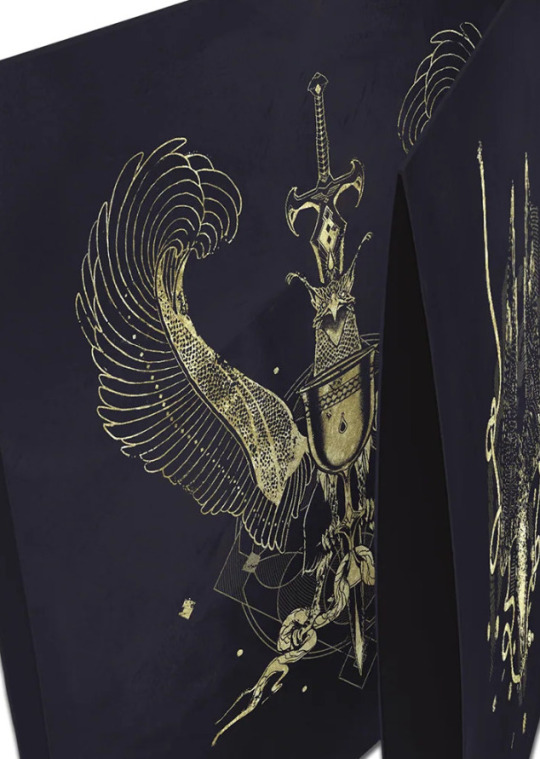
This seems to represent a griffon. It’s an uncommon Grey Warden’s symbol, since I didn’t see it anywhere before. However, the presence of the chalice with a symbol of a drop of “black” blood makes it unmistakable.
The sword that pierces the griffon’s neck also has a drop of blood, but it seems to be a white drop. Maybe this is related to the concept we learnt in the book Last Flight: as a last resource during the Fourth Blight, the Grey Warden started to force their griffons to a process similar to the Joining, but they didn’t handle the corruption well. Madness spread among the Griffons and most of them had to be sacrificed. This was the reason why the griffons went extinct.
The dagger that the griffon carries in its talons seems to pierce or be surrounded by something long and white that looks like tendrils or a snake with small branches, or a vine [which usually represents The Blight]. It’s not clear.

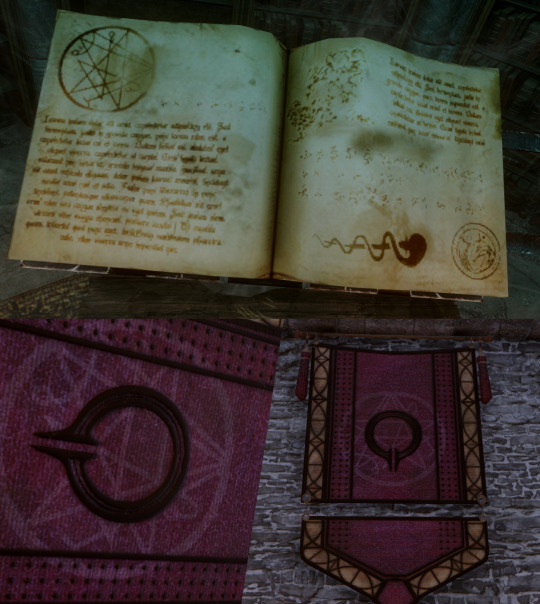
On the background, there is a symbol that looks similar to the ones we saw for glyphs or for mage organizations such as the Circle. So far, I could not find the one matching this.
I think it’s clear that this vinyl will contain the music related to the game DAO due to its strong relationship with the Gray Warden symbols.
Second Image: The Hawk and Kirkwall logo
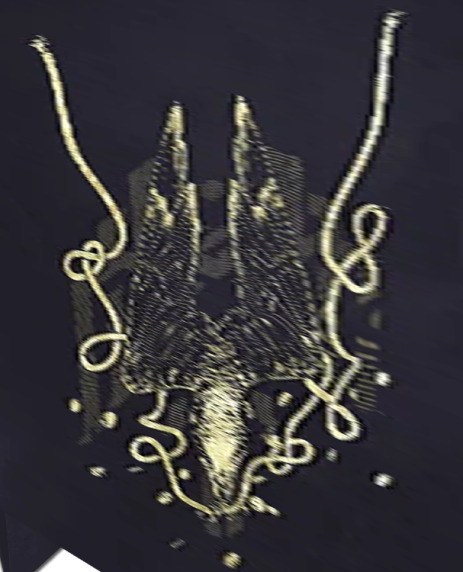
Twitter user Kiranox (@/veranox) was able to do some photo manipulation and have a better image of the second and third one despite the perspective.
As @felassan has pointed out, this symbol displays two unmistakable old ones:

The Hawke falling onto its prey, and the Symbol of Kirkwall on the background.
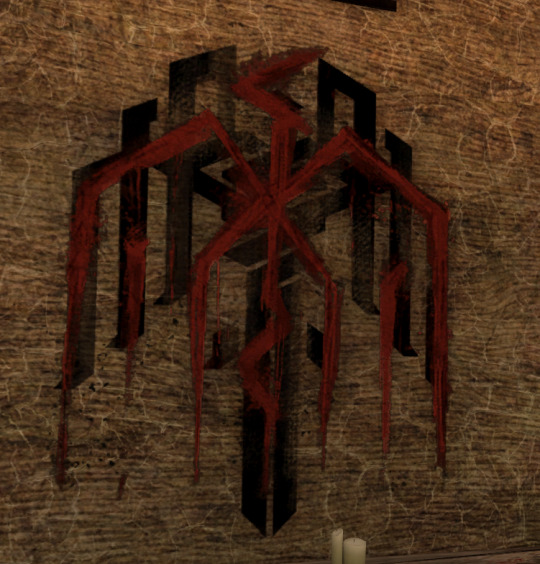
It’s curious that, in this vinyl illustration, both images are overlaped, as if they were trying to tell us that this geometrical symbol is a Hawk, when we know that, historically speaking, it was a rising dragon, from the time Kirkwall was called Emerius [more details in the post Kirkwall history and design].
When we have this image in high quality we will see it better, but the white figure also looks to me like a hawk falling free, and I can’t stop thinking in relating this to Flemeth’s words: "A word of advice, we stand upon the precipice of change. The world fears the inevitable plummet into the abyss. Watch for that moment… and when it comes, do not hesitate to leap.” Her cryptic words were always interpreted by me that the world needs Hawke to stay in the Fade. Soon, Fade and Waking World will join again, and maybe what Hawke did in the Fade until their death will be extremelly useful and key in the world that we are going to face in DA4.
This symbol also has what looks like a rope in a messy way, maybe even falling free too, with a knot in one side. The only symbol similar to this that I can relate to is Sylaise’s vallaslin, which looks like snakes or ropes in messy ways, but I don’t think there is any link between these. Is this image telling us that this is Hawke leaping into the abyss with a cut rope, and therefore, no way to return?
What I think it’s clear is that the vinyl placed in here will be related to DA2′s music due to its strong relationship with the hawk and Kirkwall symbology.
Third Image: The diagram and the hexagonal shape

If we continue this logic, this image should be a symbol representative of DAI.
What I see repeated several times here is a pattern of 6 circles, 3 of different colour and alternated. Inside of the central circle we have another set of three filled circles. This repetition of 3-circles is not something I can say I’ve seen in DAI. In fact, I’m nor really sure to what associate it with. If these were a Quincunx, we would have a lot of speculation to make since it’s a symbol present in Thedas since DAO.
These six circles are inside an hexagonal shape, which is deeply related to Tevinter, as I described in details in Patterns and Styles: Tevinter. It has a potential to be related to focis, that potentiated the power of the dreamers or priests to communicate with their dragon gods.
This design also looks similar to the diagrams that faintly appear in the background or on the body of some creatures that I talked about in Nation Art: Elvhen. However, none of them fits perfectly.
It is likely that this vinyl will countain all the music related to DAI due to the symboly of magical diagram and the presence of the Tevinter hexagonal shape.
Fourth Image: The diagram and the spheres

This is probably a mixture of all previous games with some pieces related to the incoming game of DA4.
This figure, in general, shows a Quincunx, where the central part are the three overlaped circles with a sun or a star inside.
I don’t think it can be related too much to Solas’ tarot Card [which is related to Orlesian decoration of the Winter Palace, as we can see a rug with the same kind of Quincunx symbology on it in the book of Art of Inquisition [below].

Again, as I said in Patterns and Styles: Orlais, a lot of Orlesian design and art seems to be strongly influenced by the elvhenan, so maybe this symbol has a particular meaning to the Elvhenan, but so far, I can’t think much of it beyond the fact that it is a Quincunx.

If Anything, that tarot card is showing the Quincunx symbol in itself, with Solas being the central, and therefore, the important thing. Just because these symbols have a clear Quincunx in them, one could relate the three spheres and the star in the vinyl illustration to Solas. These three spheres look like overlaping one that has a “sun”, so the meaning of an eclipse seems to be implied. And we know that Solas, in his Fen’Harel representation, is related to an ominous Eclipse, according the The Emergent Compendium I spoke about in the section “The Eclipse”.

Let’s talk about these three spheres and the star present in the vinyl: The star has the same shape to the central star we see in Solas’ mural when he draws the Temple of Mythal in “The actions of the Inquisitor”. This strengthens the hypothesis that the dragon we see in these illustations may be related to Mythal in her dragon shape.

I’m not sure if this symbology of three spheres overlapping has something to do with the mysterious symbol found at Emerald Graves: Din'an Hanin. In it, we see three golden ring of the same size, aligned. The central one is surrounded by a bigger ring, which seems to be similar to the image we see in this black-and-golden illustration: Three spheres [blue and orange ones] with a bigger ring [yellow line]. In fact, it looks like a progression: The first stage is the one shown in Emerald Graves: Din'an Hanin, where the two orange sphere approach and try to overlap the blue one, which is inside a bigger ring. The second stage is the orange circles overlaping half of the blue one [this is seen in the trailer too], and the last one is this vinyl illustration, where we see that the three spheres are inside the bigger ring and we see the middle of the blue sphere: a sun or a star, or maybe a “sphere of fire”. I talked a lot about the concept of the “sphere of fire” in Murals in DAI: Red Lyrium Idol and The Death of a Titan. A lot of more speculation in Ancient Elven codices; Vir Dirthara, and how the “sphere of fire” also leaked into the Andrastian faith in Andrastian Design: Stained Glasses.
This Star [made of eight points] is the same one that we see in the mural of Temple of Mythal, but it’s also very similar to the yellow mosaic I talked about a lot in posts such as: “The Death of a Titan” and in the tag asterisk symbol. This links Mythal with this star, which can potentially be related to the heart of the titans and this mysterious power the Evanuris discovered aside Lyrium.
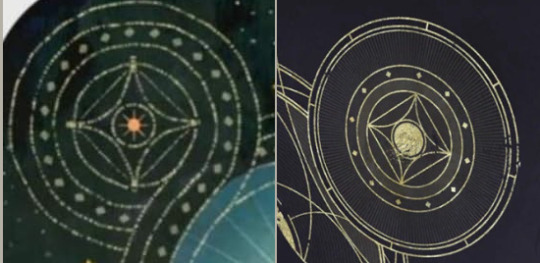
Why I don’t give to much thoughts to Solas’ tarot card? Because it’s a general Quincunx which central important element is Soals himself. Similar Quincunx symbol appears in this vinyl illustration. In fact the circles that compound this Quincunx are very similar, but those in Solas’ tarot card’s present a series of small icons: a moon, a sun, undulating lines, and four dots.
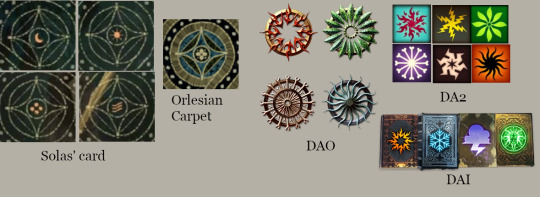
We can assume that they may be related to magic, but so far we saw in DAO, DA2, and DAI, all these symbols come from the Circle, and therefore most of them keep recreating the Chantry icon, or are inspired in it: all of them are very close to the design of the sunburst. The Orlesian carpet has a small flower in it, which is a very typical icon present in all orlesian design.
But Solas’ tarot card has four clear symbols:
We can agree that Sun/Moon may have some relationship with Mythal/Elgar’nan, since there is information that relates them, but sadly the only source we have for that is the Unreliable Dalish Tales, so it’s hard to be sure. These both symbols are also related to the Eclipse symbology that, at this point, we can’t deny as related to Fen’Harel.
The undulating lines have been associated with “shape and control” according to the info I gathered in “Murals in DAI: Basics” in the section “Undulating lines associated with Vallaslin or/and bound-slavery”.
The dots, so far I remember, were never seen in any game. I can only relate them to these four-petal flowers in the Orlesian design, but since we are talking about Elvhenan, it must have come from an older symbol. Maybe it’s something related to the Forgotten Ones or the Titans indeed, both groups quite unknown in the lore still. The other posibility to understand these four dots is to represent a Quincunx symbol without the middle dot.
#old gods#dragon#Quincunx#evanuris#mythal#tarot cards#eclipse#Golden Ring#fire sphere#sphere of fire#Bull horn head creature#forgotten ones#Dreamers#elvhenan#codex focused#High speculation
32 notes
·
View notes
Text
Dragon Age Iconic Patterns: The single spike

The single spike or horn has been a constant pattern throughout all games of Dragon Age in general and in DAI in particular. There are several things that may be linked to it, from Mythal and Andraste to Dragons. In this post we explore how many of these objects present such pattern and how this may be related in an integral way.
This post contains the following statues:
Andraste
Wyvern
Mythal
The red lyrium idol
Tevinter or Venatori outfits
Tevinter Dragon
Tevinter golems
Tevinter Colossus
Andrastian Free Marches warriors
[This post belongs to the series “Analysis and speculation of Statues”]
Andraste
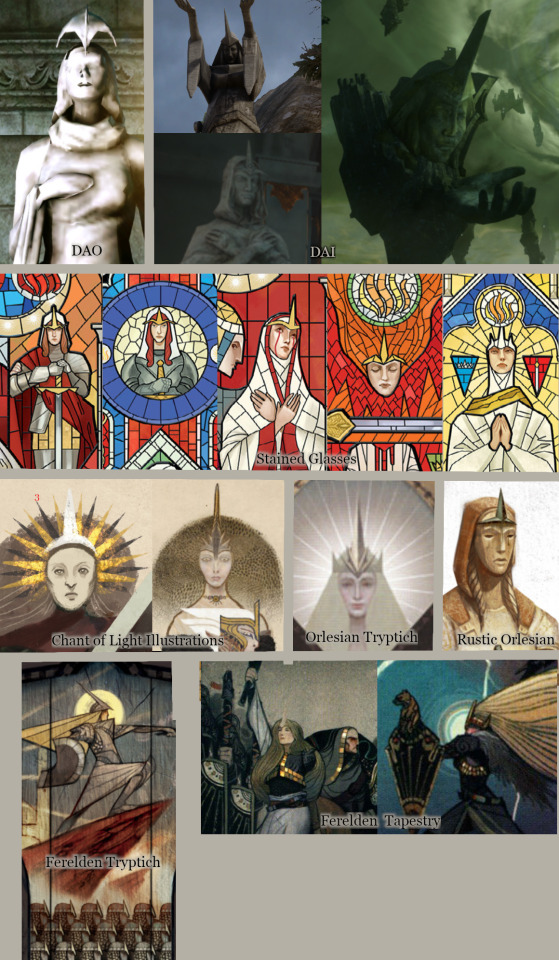
The main figure we see with a single-spiked helm in DAI is Andraste, who is depicted in numerous pieces of art along the game and books. Although she doesn’t wear this single-spiked helm in all of them, it’s an iconic representation of her [to the point that some followers are depicted with similar tiaras/helms such as Meredith]
In DAO we only have one unequivocally representation of Andraste, which is the statue we see at the end of the Temple of Andraste where her ashes are supposed to rest. In this case, the helm has the shape of a “moon” or similar. This form will be changed since DA2, and it will turn out to be the iconic single spike. We can attribute this inconsistency to the many difficulties in resources and environmental telling that DAO had.
Most of the time, Andrastian art represents Andraste with this single spiked helm/tiara [more details in Andrastian Statues].
In the illustrations found in the Chant of Light we can suspect that such a single spike is related to the shape of one single sun ray.
Wyvern

These animal statues appear all over Ferelden and in some parts of Orlais and in the Frost Back Mountains. In the tag Ferelden Wyvern we can track their presence along DAI. That they appear in Ferelden is not surprising, but the fact that they are inside ancient Pre-Blight Tevinter ruins [check Western Approach: The Still Ruins, Main Chamber and Hall of Silence and Western Approach: The Still Ruins, Viridis Walk and Inner Sanctum] is very disconcerting, specially taking into account how central it is in The Still Ruins, which appears even in the loadscreen of the zone. One could suspect this may have been product of the Dragon fascination that Tevinter culture had/has. Still, it seems odd to honour a lesser creature such as a Wyvern when they usually worshipped the true Dragons.
This statue appears in the Fade as well, but it has a clear design choice: the game shows us a wyvern in front of a head of Andraste, pushing us to ask why such an irrelevant statue would be in front of something so important as it is Andraste. The answer is solved later in the book World of Thedas, where we find that there is a Ferelden Tale which related wyverns with Andraste:

Now, this Tale is quite curious. If we always keep in consideration that this piece of lore is highly unreliable since it’s a tale spread in a population via oral narration, and subjected to changes over ages without records, we can highlight several details:
Andraste goes to the Mountain to “reach the Maker”. In the Chant of Light, we know that she speaks with the Maker, who is described Mountain-like. This reinforces the idea that Maker=related to Mountains. I assume this is a cultural remnant of the alamarri/avvar origin of Andraste, who had a deeper relationship with Korth, the Father-Mountain.
Andraste sang, and with this song, a “wyvern” appeared. This may potentially bring some relationship with the Dragons and the original song I talked about in posts like The Silent Grove, Those Who Speak, and Until We Sleep. We can even suspect that maybe instead of a Wyvern, the original event that inspired this Tale may have related a true Dragon. After all, we know that this single spike in the wyverns may, potentially, have some relationship with the dragon shape of Mythal. We also know that Tyrdda had an elf lover who sent a dragon to help her people, so I wonder to what extent the Alamarri and Avvar had also some level of relationship with mountain dragons.
It’s still a big question to understand how this wyvern statue, so related to Ferelden culture, appeared in pre-blight Tevinter buildings, when Ferelden did not exist as it is now. This is what reinforces my question: are these wyverns potentially creatures related to the Great Dragons? So far, we have no answers.
Mythal

Mythal, in all her representations and shapes, also wears an iconic single spiked helm. Even in the Concept Art, where we can see wavy sided horns that did not make it into the game, we cannot mistake the single centred spike. In dragon shape or in her humanoid form, this spike is constantly present.
It is unclear how this design choice may potentially speak to the player to relate Mythal to Andraste. One can speculate that, maybe, a fragment of Mythal appeared to Andraste. Maybe the Maker that Andraste claims to hear was, in fact, Mythal’s fragment. It would have been very convenient for Myhtal to instruct Andraste to make her Exalted March on Tevinter if we keep in mind that Flemeth [another fragment of Mythal] has been altering History to push it into a direction she has been planning for ages.
Flemeth’s Tiara
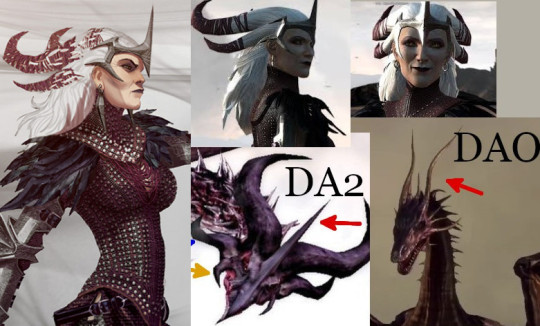
Flemeth’s tiara also has a structure that shows a single central spike in a very prominent way. The relationship is obvious: Flemeth is Mythal. Or at least, a surviving fragment of her.
Her dragon shape is different in DAO than in DA2. In DAO it’s the model of a general high dragon [as usual, DAO didn’t have the most variety of visual resources so we can’t read too much in it], while in DA2, Flemeth has a clear dragon shape with a single spike in its horns that can be related to that tiara.
The red lyrium idol

The Red Lyrium Idol also shows a prominent central spike in the head. It’s a constant symbol that allows us to do some speculations: in the post Attempt to rebuild Ancient Elvhenan History I speculated that Mythal's assassination may have inspired this idol, and therefore, this single spike seen in the idol is what relates it to Mythal herself.
It’s curious that even when Meredith turned into a piece of Red Lyrium, she also displayed a single spike in her head. This may have been just a consequence of the helm she was wearing in that last battle, which was clearly a helm trying to emulate Andraste’s.
From a design point of view, I think it’s clear that the game is telling us that this idol is related to Mythal/Flemeth, even though we are still blind about the “how”.
Tevinter or Venatori outfits
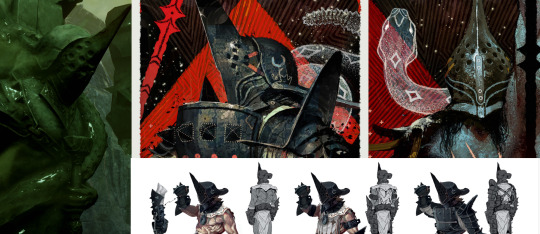
I already spoke about this in the section “outfits” in Patterns and Styles: Tevinter. We know that Tevinter has a long history of dragon cults, and until the moment the nation turned into the Andrastian Faith, the Old Gods Cult was its strongest religion. The fact that a dragon [Mythal] has a single spike horn, and Andraste also has this icon in her art, makes us hard to understand the origin of the symbol in Tevinter Design. It could have been due to the Dragons, but also, as a design choice once they were converted into the Andrastian Faith. Let's remember that Dorian tells us that Tevinter thinks that Andraste was a mage, so more reasons to have her icons among the Tevinter Warriors since they have mage-inspired armours.
I also explained that it's hard to differentiate the Venatori from non-Venatori Tevinter design simply because the Venatori are nationalist, so they will always use the most iconic symbols of their nation.
There is a strange link between this design and the one I called “The Free Marches Andrastian Warriors”, which display a strong Tevinter-like style, but remaining Andrastian. These statues may keep that single-spiked helm as a representation of Andraste, but also as a remmant of Tevinter design [more details in Andrastian Statues].
Tevinter Dragon

For completion’s sake, I add this detail: these typical Tevinter dragons display a single horn. At some point one wonders if these statues are related somehow to the design of the Wyverns or are a development of worshipping Mythal-dragon.
Tevinter golems

These Tevinter golems trigger the codex the Gate Guardians . They are metallic statues that, we are told, were powered at some point by bars of lyrium.
They also display a single spiked helm, that, due to the general looking of the golem, looks like a Tevinter representation of Andraste herself.
The golem in general has resemblance to some pieces of the armour of the Humanoid Mythal.
Let’s remember that Golems were developed by Dwarves during the First Blight, and due to their trade relationship with Tevinter, they sold some [Golem and Legend of the Juggernaut] that were displayed on the entrance of Miranthous, inactive. So it seems that, historically speaking, makes sense that these golems may have been developed into resembling Andraste since Tevinter embraced the Andrastian Faith after the beginnig of the First Blight [check all this in the integral post The Chantry and the Mythology of the Chant of Light]
Tevinter Colossus

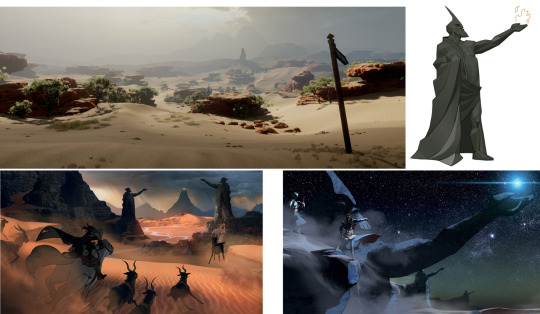
Among the Tevinter sculptures, we find one of the most mysterious one: the colossus. They are found closer to the structures that belonged to Tevinter in pre-blight times.
In game there are three different Colossus, found in Western Approach: Coracavus; Front Corridor and South Entrance, in the open of Hissing Wastes: scattered objects and ruins, which was being co-opted by Orlesians to make it into a sculture of an Orlais Emperor, and inside the Frozen Gates in Frostback Basin [DLC]: Frozen Gate.
The book World of Thedas gives us more concept art about these structures, which seem to be related to “guiders” and, maybe, to astronomy too.
The fact that we can see one of these in a concept art, showing up a certain star over its hand, makes me suspect these statues belonged to the ancient Dreamer times, that the codex Astrariums claims that Tevinter was under before the Magisterium was the mandatory political system.
The heads of these colossus are not exactly single spiked heads, but one of them [The Coracavus' one] has one single spike that fuses with the bridge of its nose, while the other two, have "horns" backwards. Maybe we can suspect some dragon inspiration in them? I find their profile very similar to the Qunari ones’.
Andrastian Free Marches warriors

These were seen for the first time in DA2, and they decorated The Chantry of Kirkwall. They look similar to the Tevinter Warriors thanks to this spiked helm and pointy shapes, but this may be attributed to the fact that Free Marches have a strong Tevinter influence.
However, these statues have an unmistakable robe identified with the ones worn by the Chantry priests in DA2.
This single spike in their helms may be related to Andraste herself and her own helm/tiara, but also having some inspiration from Tevinter.
Conclusions
I think it’s fair to say that the “Single Spike” is an unequivocally symbol of Andraste that may have an inspiration or a relationship with dragons in general, or with Mythal in particular. By extension, and due to Mythal’s dragon nature, this Single Spike also appears in Tevinter culture, even in elements that are suspected to be pre-Blight, and therefore, impossible to be inspired in Andraste herself. So, as it happens with DA lore, and assuming what we did in the post Attempt to rebuild Ancient Elvhenan History, everything comes to primordial dragons that may have inspired this icon in Tevinter Culture and later, in the human tribes, from where the Andrastian Myth and her religion raised.
#single spike#single horn#mythal#Humanoid Mythal statue#Dragon Mythal statue#tevinter dragon#tevinter#free marches#free marches design#the colossus#tevinter golem#venatori#red lyrium idol#flemeth#andraste#andrastian design#andraste statue#Ferelden Wyvern#Analysis and speculation of Statues
21 notes
·
View notes
Text
Andrastian Statues
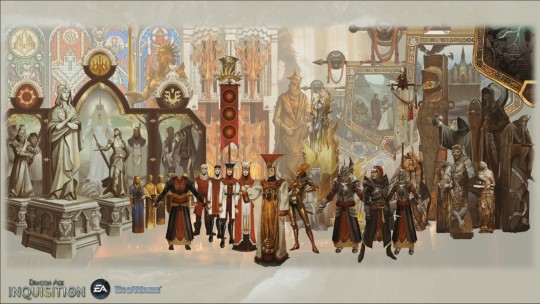
The purpose of this collection of statues is to show the Andrastian style depending on the region, the details in it, and how this may or may not influence other statues we saw in game. I also attempt to recollect some interpretations of them, although most of them are mostly based on speculations.
The current post contains the following set of statues:
Ferelden Style: Pre-Divine Andraste, Chasind Andraste, Ferelden warrior protector Andraste, The Maker, The Dwarf [?], Rider Maferath [?], Masferath Repentant, Hanged Masferath, Other Statues.
Orlesian Style: Rustic Maferath, Hessarian, Andraste; The Orlesian Warrior Andraste, The Stylised Orlesian Andraste, The Orlesian Andraste, The Orlesian Maferath, The Orlesian Havard, and the Orlesian Hessarian; The Weight of War
Free Marches Style: The Free Marches Hessarian, The Free Marches Andrastian Warriors [?]
Unknown Style: The Skull with sword, The Guide, Guardians of the Path / The Watcher.
[This post belongs to the series “Analysis and speculation of Statues”]
Ferelden Style
Pre-Divine Andraste
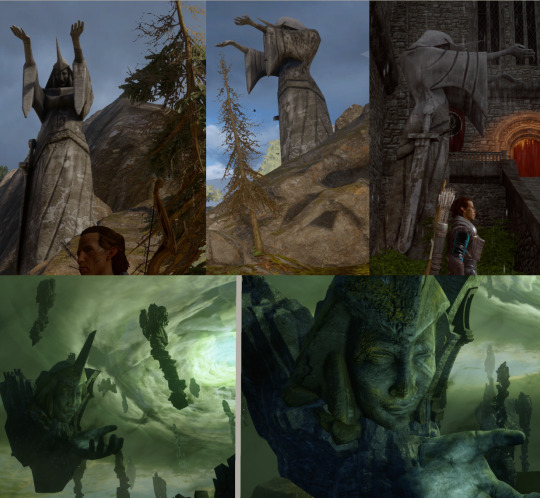
One of the most iconic statues in DAI.
It’s present all over Ferelden, specially in big, colossal statues along the paths of Hinterlands. They are so big that sometimes one can overlook them unless you look upwards [check Hinterlands: Statues, paintings, and structures found in the open].
In Skyhold, we can find this statue in a small version in the local chapel, which triggers the note Bride of the Maker.
Thanks to the DLC Jaws of Hakkon [Main Chamber of Razikale’s Reach], we know that this statue belongs to a pre-divine time. It is probably one of the oldest representations of Andraste we have in-game.
As usual, she has a one-spike helm that has strong resemblances to Flemeth’s tiara, and to Humanoid Mythal statue, Dragon Mythal statue, and the Ferelden Wyvern.
She has a sword in her hip.
Her sleeves and skirt have long lines that emulate folding. It’s a style we saw in statues that were considered “elvhen” in-game [for example, the Elven Archers or The guide]. But we can see this became an Andrastian style since we also see it in the Blocky bearded humanoid.
Her gigantic hands have been used in several elvhen places, and I wonder how meaningful these are: these hands appear in Exalted Plains: the Dead Hand as well as in the Shattered Library, holding eluvians. Is this a mere reuse of resources or hides some lore in it? We know DAI is less lazy about this than previous games.
This statue is curiously aligned with Humanoid Mythal statue in the Fade, as well as with the Imperial Highway Columns [check The Raw Fade: Part 1]. A Design choice that keeps me wondering if it hides some meaning in it.
Chasind Andraste
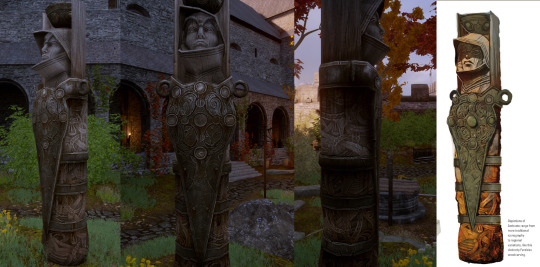
It has the design of a totem.
Its relief is very intricate.
She is represented as a protector warrior due to the strong presence of the shield on it.
We can suspect this statue is also ancient, and you can see that it has similar style to the Alamarri Monolith with swirls we find all over Hinterlands.
If you pick the Chantry-related garden in Skyhold, this statue appears in it and the archivist Banon will mention details about it in The Women of All War. He claims it’s Chasind, not original from Skyhold, brought by Ferelden into the castle. He also suggest it’s a re-usage of an ancient totemic statue.
This last comment streghtens the idea that ancient Andrastian art tends to be done over or using/co-opting statues from previous civilisations.
Ferelden warrior protector Andraste
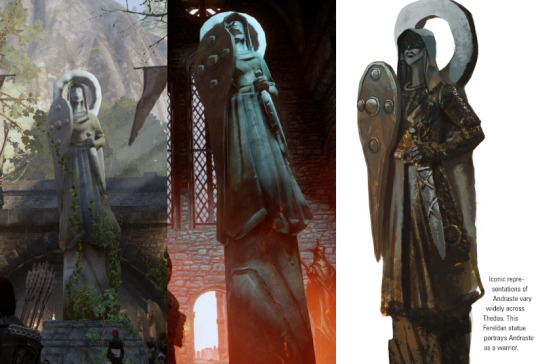
Another classic representation of Andraste in game.
It’s Ferelden style.
She is represented as a warrior [holding shield and sword] but also as a divine entity [I suspect the ring behind her works as a rustic design of a halo].
There is a chance that the thick “halo” could be an adaptation from another icon we saw among the Elvhenan design: the Golden Ring. How is this possible? I think it’s not too strange considering how deeply related to the elves the Avvar are. If we think that part of this culture comes from the Alamarri, one could guess that through the elvhen lover that Thrydda had, some elvhen presence has been around this culture to incorporate elvhen iconography in their own art, translated later into something of this shape.
The Maker
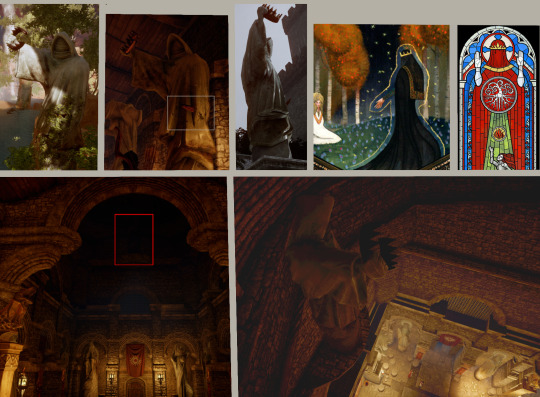
This mysterious figure has no face, in fact, it looks like bandaged. In his right hand holds a crown, while in his left hand, a dagger. The outfit is a very simple robe.
The dagger is quite curious for a representation of the Maker.
This statue took me a long whlie to identify. In early posts I kept calling it Faceless figure holding a crown. I came to the conclusion it is the Maker.
This statue appears always within the context of the Andrastian statues, so it could not be asumed in any other way than related to the Andraste Myth. In the posts Andrastian Design: Stained Glasses and Andrastian Design: Tapestry and Tryptich, we can see that a figure with no face and wearing a crown of similar characteristics is represented as the Maker. These are my main arguments to be confident about this identification.
In Hinterlands, he appears in the main hall of Haven very high upon the hall, hidden in the shadows, in a room filled with andrastian iconography, which reinforces the idea that it represents an entity that is above all of them, Andraste included. Another confirmation of being the Maker.
It also appears in the Tyrdda Bright-Axe Path, which has a mixture of statues, and in Forbidden Oasis, when the place was took by the Andrastian forces. It also appears in the mysterious Hinterlands: The Unknown Ruin. Other more natural and Andraste-related places where we find it: Redcliffe - Future, Therinfal Redoubt, Western Approach: Adamant Fortress.
The Dwarf [?]

This figure was tag along the blog as Blocky bearded humanoid. It is found in the main hall of the Templar building of Therinfal Redoubt and in the corridors of Redcliffe - Future
The design of this statue feels closer to the pre-divine Andraste. Maybe it has some influence of the Alamarri style.
The long lines on sleeves and chest seem to suggest similarity in style with the pre-divine Andraste but also with the elvhenan statues such as the Elven Archers, or The guide.
Its face seems to show a big smile, but if you see it with more detail, it may also represent a long, long beard. The broad constitution, the big ears, the lack of hair, and the prominent beard seem to suggest a golem-like or dwarven representation.
I can’t say I can identify this figure in the Andrastian Myth, but it’s related to the Andrastian Faith since it appears where there are other andrastian figures.
If this figure comes from the Alamarri and it was co-opted by the Andrastian faith, I could suspect that may be related to the dwarven culture that Alamarri had. If we remember Tyrdda Bright-Axe Path, she had a child with a dwarven prince. The Chasind also had mixed descendants of humans and dwarves. So, if it’s an alamarri statue co-opted by the Chantry, it could not be strange for it to be a dwarf. These details may indicate that the Alamarri had a deeper relationship with not only elvhen, but also dwarves, and this aspect appeared in the art until co-opted by the andrastian faith resulting in this figure.
Rider Maferath [?]

This statue appears only in Fallow Mire. Although, the same statue appears riding a horse in Crestwood: surface. Maybe it’s a mere reuse of resources.
It has a similar design to the Blocky bearded humanoid.
It represents a man with a beard, and its angular design may suggest similar time and style than the previous one.
More details in the section Other Statues from this post.
Masferath Repentant

Mostly seen in the region of Ferelden [although, you can find it too in Western Approach: Adamant Fortress]
This is the typical Ferelden statue of Masferath, regretting his betrayal.
He is sitting on a stone which has a design of a snake surrounding it, representing the Tevinter influence or deal he made with the Archon before handing over his wife.
The helm in this statue has a C-shape, which I find very similar in design to the Tevinter helms [check section “Outfits” in Patterns and Styles: Tevinter]. I’m not sure if this is mere coincidence, or it speaks of a common [dragon-inspired] origin source.
Hanged Masferath
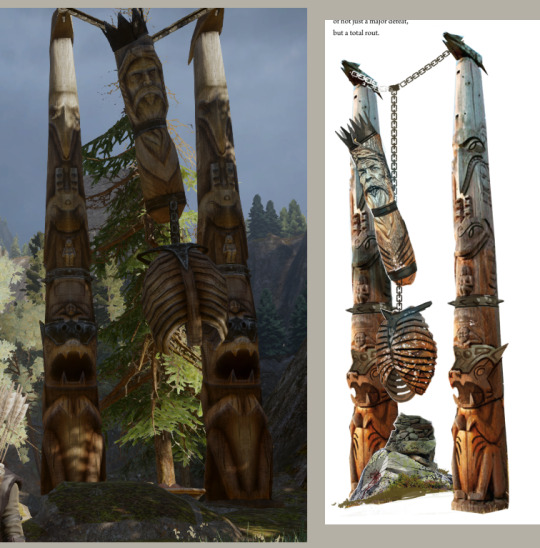
This totemic sculpture can be found in Hinterlands: Statues, paintings, and structures found in the open.
This is a Ferelden representation of Masferath being hanged. Clearly Ferelden has a strong sentiment with his betrayal.
The totemic structure seems to show mabaris at its base, followed by two different kinds of birds or maybe it’s a dragon [hard to say].
The top of these totems keeps bringing my attention: I can’t stop thinking there may be some link with the Tevinter metallic statue that I called “Tevinter bird”, found in Ferelden in the underground region of Crestwood: Flooded Caves.
Other Statues
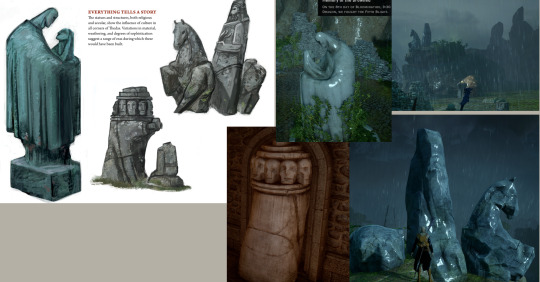
The couple can be found in Hinterlands: Redcliffe - Present, as a symbol to remember those who died in DAO-Redcliffe. It can also be found in Crestwood: surface as a memory statue of the drown, and in Frostback Basin [DLC]: Nigel’s point, as a memory statue of Ameridan’s friends: The templar Haron and the dwarf Orinna. It feels more like a reuse in most cases since it’s a strange statue to represent "fallen/lost people”. Certainly we can assume it’s Ferelden made.
The horse with the rider seems to have, as we see in its drawing from the book Art of Inquisition, a lot in common with the previous statue I called “Rider Masferath”. The horse has been removed in some other places to only let the human figure stay. It can be seen in Fallow Mire without his horse, and in Crestwood: surface. Sometimes the rider is not well chiselled in the stone.
The vessel with many faces is only seen once in the game, in the The Darvaarad - Part2. We know the Qunari took this castle and put a lot of statues that they gathered around the world. However, this statue of many faces looks like it belonged to the inner corridors of the castle, implying the castle per ser may have been Ferelden, or elvhen in origin, but repurposed by Ferelden later. In the game we only see the “back” part of it, while in the book Art of Inquisition, we can see the full statue, which implies a beheaded figure. Maybe it’s the representation of a jury. It could also be interpreted as an entity that puts “the right head” into the people, suiting the Qunari and their Qun philosophy, but this interpretation would make me question why it is so related to Ferelden art in the Art Book.
Orlesian Style
Rustic Maferath, Hessarian, Andraste
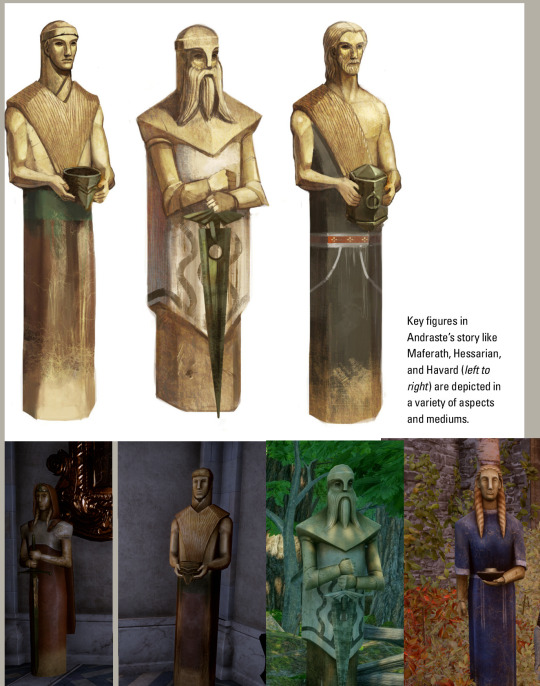
A bit distant to the style of the Blocky bearded humanoid, we have these series of statues representing typical characters from the Andrastian Myth.
They are mostly located in different areas all over Orlais [or inside the Skyhold if you pick an Andrastian garden].
We find Andraste, in blue and red [I’m assuming one is the bride of the Maker, while the other is the warrior protector of her people]
Masferath is carrying a crown (?) in his hands, and Hessarian is holding the Sword of Mercy.
These seem to belong to an Orlesian style but rustic or more “popular”. They give me the impression that were made by the working class people who could not afford realistic artists to sculpt them in stone.
They seem to be made out of wood.
The Orlesian Warrior Andraste

Unlike the previous one, this Orlesian statue is made out of stone and is bigger, more detailed, and realistic. It seems to appear in rich/high class places.
It also appears in Emerald Graves: Din'an Hanin, which may represent the influence of the Andrastian faith among the Ancient Dalish when the Dales was their Kingdom land granted by Andraste herself.
This statue presents Andraste as a warrior: she is wearing a detailed armour, a big sword, and, curiously, a helm that has no iconic single-spike. However, I can see some similarities in the armour design to Flemeth’s armour or the armour used by Humanoid Mythal statue.
Due to the strong similarities in style, this statue belongs to the same group than the Orlesian Andraste, Orlesian Maferath, Orlesian Havard, and Orlesian Hessarian.
The Stylised Orlesian Andraste

Another over-detailed statue of Andraste made out of Stone which appears in wealthy places.
The whole design of Andraste has a strong similarity to Tyrdda Bright-Axe, which may suggest that this statue may have a strong alamarri influence, mixing Andraste tale with the representation of Tyrdda.
The icon that represents the sun, ironically, has a strong similarity with the statue I called Sun-head creature, deeply related to the Elvhenan and, potentially, to Tevinter and its old dragon gods. This may imply that this statue may have collected several icons and details from different cultures and faiths to gather them in the cult to Andraste. This process is well known in human History, where the forced religion tries to blend with the local ancient one to produce an assimilation of the new faith.
The Orlesian Andraste
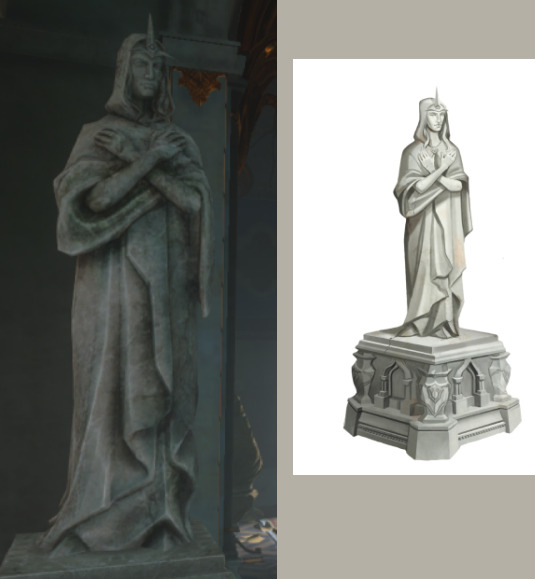
This Orlesian statue is made out of stone and is bigger and a lot more detailed and realistic that the “wooden” sculptures.
It tends to appear in wealthy places as well as inside the Chantries of the game.
It represents mostly the divine Andraste and the bride of the Maker, without any element of her warrior side.
She has a one-spike helm that has strong resemblances to Flemeth’s tiara, Humanoid Mythal statue, Dragon Mythal statue, and the Ferelden Wyvern.
Due to the strong similarities in style, this statue belongs to the same group than the Orlesian Warrior Andraste, Orlesian Maferath, Orlesian Havard, and Orlesian Hessarian.
The Orlesian Masferath
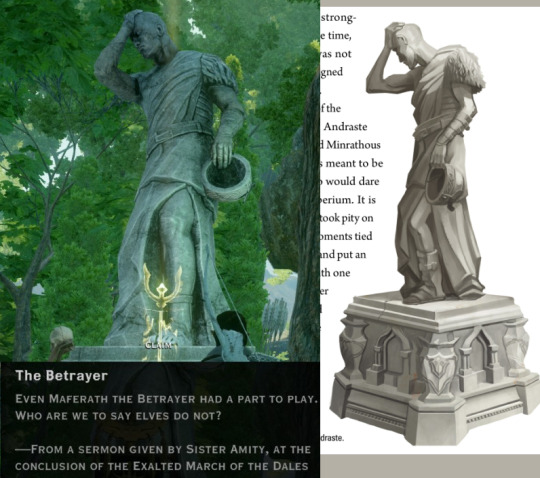
It is called “The Betrayer”.
We see the man worried, grabbing his own head, showing the weight of his own betrayal. He keeps the crowd of his leadership of the Alamarri in his hand since the Chantry tale says that he betrayed Andraste out of jealousy because she was more important than him among their people. I always questioned this since he was the one commanding the armies and their people into Tevinter, and he may have chosen the “lesser bad” option [read the The Chantry and the Mythology of the Chant of Light for more details].
Due to the strong similarities in style, this statue belongs to the same group than the Orlesian Warrior Andraste, Orlesian Andraste, Orlesian Havard, and Orlesian Hessarian.
The Orlesian Havard

Havard is shown here with avvar clothings [fur-based].
He is carrying the urn of Andraste’s ashes that will be placed in Haven and will become later the Temple of Andraste [DAO].
We know thanks to the notes triggered in it that this statue seems to represent Havard but its appearance was based on a noble’s lover [check it in Emprise du Lion: Pools of the Sun].
Due to the strong similarities in style, this statue belongs to the same group than the Orlesian Warrior Andraste, Orlesian Andraste, Orlesian Maferath, and Orlesian Hessarian.
The Orlesian Hessarian

He is holding the sword that will be called the Sword of Mercy, used to kill Andraste in the pyre so she could not suffer anymore.
His hat has a bent T-shape that we can see in many other helms of Tevinter warriors in the section of “outfits” in Patterns and Styles: Tevinter.
Due to the strong similarities in style, this statue belongs to the same group than the Orlesian Warrior Andraste, Orlesian Andraste, Orlesian Maferath, and Orlesian Havard.
The Weight of War

This statue was tagged in this blog as Man holding bigger head for a long while.
It has appeared in Forbidden Oasis, Redcliffe - Future, and in Orlais: Winter Palace.
Thanks to the constant presence of Andrastian-themed art around it, I could finally assume that this statue belongs to Andrastian art in Orlesian style.
The main man has angular features, his ears are not visible since it looks like he is wearing a chain-mail. He uses scale-based pauldrons, and a robe. He is holding a sword with one hand while the other holds a bigger head. By comparison with the state of the overall figure, we can assume that the bigger head has a lot of wounds and scars [meaning that this is part of the sculpture design and not a consequence of erosion].
Despite looking similar, the head in his hand and this man’s profile are different. The bigger head has a smaller, shrank nose.
The only significant shape in this statue that can give us a resemblance of a hint to whom it belongs is his belt, which has pointy ends. We had seen this pattern in two places: in Tevinter artefacts, such as the sacrificial burial, or in andrastian outfits.
It triggers a codex called The Weight of War which is a bit unreliable, since the person explaining this is an amateur historian, but it’s the only hint we have about this statue. The amateur historian implies that this statue may belong to a warrior with a philosophy similar to the Grey Wardens.
More details about this statue in the post Forbidden Oasis.
Free Marches Style
The Free Marches Hessarian
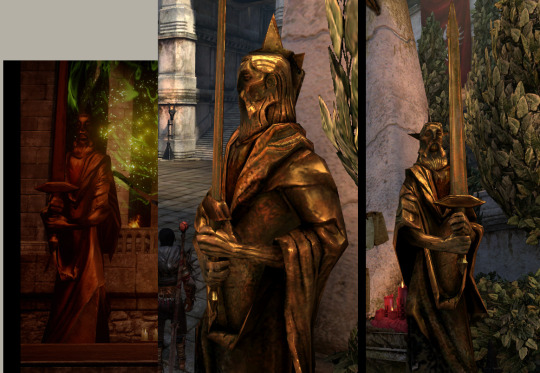
It appears mostly in the Templar fortress of Therinfal Redoubt
This statue has a strong resemblance to Tevinter art. It’s not only the dark metallic material used for the sculpture, which was strong similarities with Tevinter artefacts such as Thrummer, Water dispenser, Tevinter urn, Tevinter artefact with spikes, Tevinter golem or Claw of Dumat, but also the prominence of angles and pointy ends.
There is no codex associated with this sculpture, but I can guess it may represent Hessarian [the main Tevinter figure in the Andrastian Myth] since this statue has a version carrying a sword.
It has a long beard and hair.
This statue has also been present in DA2, specially in the Chantry district of Kirkwall [check it in Architecture of Kirkwall : The Chantry].
The Free Marches Andrastian Warriors [?]

It appears mostly in the Templar fortress of Therinfal Redoubt and in the Fade.
This statue has a strong resemblance to Tevinter art. It’s not only the dark metallic material used for the sculpture, which was strong similarities with Tevinter artefacts such as Thrummer, Water dispenser, Tevinter urn, Tevinter artefact with spikes, Tevinter golem or Claw of Dumat, but also the prominence of angles and pointy ends.
It’s wearing a typical DA2 Andrastian robe, but the helm has always brought my attention: it has a lot of more similarity to the Tevinter warriors than to the one-single spike helm of Andraste.
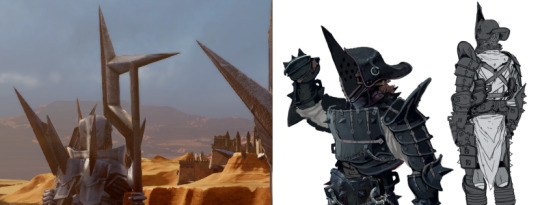
Its weapon also has a strong similarity to the weapon used by Tevinter golems, while its helm has strong similarities with the ones that belong to the Tevinter warriors. One may say that both of them, in fact, are representing the one-spike helm of Andraste.
The unmistakable identification with Andrastian faith is given by the robe: if we see the chest, we will see the pointy half sun on it, which was the main design of the outfit of Elthina and other chantry priests we saw in DA2.
Unknown Style
The Skull with sword
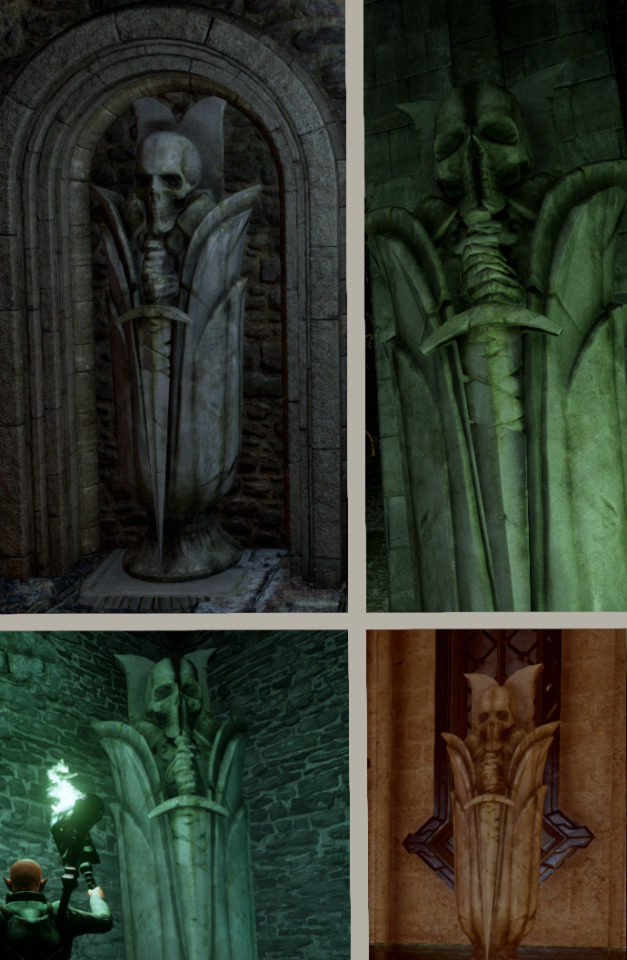
This is the statue that I called Skull bud with sword all over this blog.
The skull is quite long for a regular human. It holds a sword. The body seem to be inside a bud or a shell that may look like a flower bud but also as the shell of an insect/scarab.
This statue has always appeared within Andrastian contexts such as in Frostback Mountains - Haven [the basement], Hinterlands:Dead Ram Grove, or Ferelden: Therinfal Redoubt, but also in places where the Andrastian context is not that strong, but still yet reasonable to appear, for example in Hinterlands: The Unknown Ruin [overtaken by Andrastian faith lately, so far we see in the statues present in this room], or Emerald Graves: Din'an Hanin [which clearly shows how the Ancient Dalish allowed a certain level of assimilation of the Andrastian faith thanks to Andraste’s gift of the Dales]. However, we also find this statue in Western Approach: The Still Ruins, Viridis Walk and Inner Sanctum, which is a pre-blight Tevinter building, so one is inclined to think that this statue may have been Tevinter in origin, and somehow, adopted later by the Andrastian faith. Or maybe it’s just Elvhenan, taken first by Tevinter, and later by the Chantry [as we see this pattern repeats over and over with everything related to Tevinter].
One of the potential interpretations is that this sculpture represents a coffin, or a dead who is put to sleep in this position. The fact that this skull is inside a bud or an insect shell [in addition to the speculation that, like all what comes from Tevinter, was originally elvhenan] brings the possibility of being related to Uthenera and the mysterious codex of Vir Dirthara: A Flowering Imago that I tried to multi-interpret in several ways in Ancient Elven codices; Vir Dirthara.
So far I know, there is no codex associated with it, and we have only speculations about it.
Its style is not strongly similar to all these Andrastian statues, but the fact that it appears mostly within andrastian themed rooms, it’s hard not to bring it into this post.
However, I’m not confident about how to understand this statue and to what culture associated it with.
The Guide


It can be seen in three places only: Emerald Graves: The open pointing more or less towards Elgar’nan’s Bastion, on top of Stone-Bear Hold Avvars - Part 2 pointing out to the sea, and in the Fade, exactly in Flemeth’s Fade: Part 2, pointing the path towards Mythal/Flemeth.
It’s associated with the unreliable landmark called The guide [written by this orlesian scholar who lacks of deep knowledge of elven culture], which identifies it as an elvhen statue, but it has a lot of style similarities to the Blocky bearded humanoid and the pre-divine Andraste as well as to the Skull bud with sword. If we see the back of an Elven Archer statue, we can find line-based similarities too, so it’s hard to decide whether this is truly Elvhen in origin and co-opted by the Andrastian and repurposed later, or it truly belongs to the set of pre-divine statues we spoke above and this amateur scholar misunderstood it as Elvhenan.
The unreliable landmark links it to Falon’Din for the mere fact that it is pointing out a place, so it “guides”. If we overlook this pathetic logic, and we give it a remote chance for it to be elvhen, we should be careful to identify it with Falon’Din. First, Via Solas, we know that Falon’Din was far from guiding people [Check Evanuris], and second, even if we consider this statue to be Falon’Din, we should never forget how Falon’Din and Dirthamen are entangled one another [check Humanoid Dirthamen], so this could also be a statue representing Dirthamen. The shape of the sleeves has some resemblance to the Elven Owl statue [they have long lines along it], but once more, both gods are so indistinguishable one another that it’s hard to say who is who.
Guardians of the Path / The Watcher

This hooded statue was called Humanoid Dirthamen/Falon'Din in this blog.
The hooded statue can be seen in four places: in Emerald Graves: The open, as a watcher of entrances, in the Hinterlands, along the Tyrdda Bright-Axe Path inside the Calenhad’s Foothold; in Exalted Plains: Northern Ramparts and Citadelle du Corbeau, as the main big statue when you step into the Citadelle [again, watching over an entrance] and in Flemeth’s Fade – Part 2, as a statue bleeding profusely with a sword in its back, as an unmistakable symbol of betrayal.

In all these cases, the hooded version of the statue seems to be related to “watch or protect entrances”. Due to its presence in the Fade of Flemeth, we also can associate it with deep betrayal.
Once we see how the pattern unfolds with the statue I called Humanoid Dirthamen/Falon'Din [hodded version] we can understand the Andrastian version “guardian of the path” in similar fashion [he always appears in entrances as well], suspecting it was a re-usage and co-opt of the elvhen hooded statue when the Andrastian forces conquered the Ancient Dalish's lands.

The Guardian of the Path appears twice in game: in Crestwood: surface, at the entrance of the region, similar position as the hooded versions in Emerald Graves, and in the entrance to the region of the Exalted Plains.
#andrastian design#andraste#The Guide#guardian of the path#Skull bud with sword#Man holding bigger head#orlesian design#ferelden design#Humanoid Dirthamen/Falon'Din#andraste statue#hessarian#havard#Maferath#blocky bearded humanoid#Faceless figure holding a crown#the maker#maker#Analysis and speculation of Statues
18 notes
·
View notes